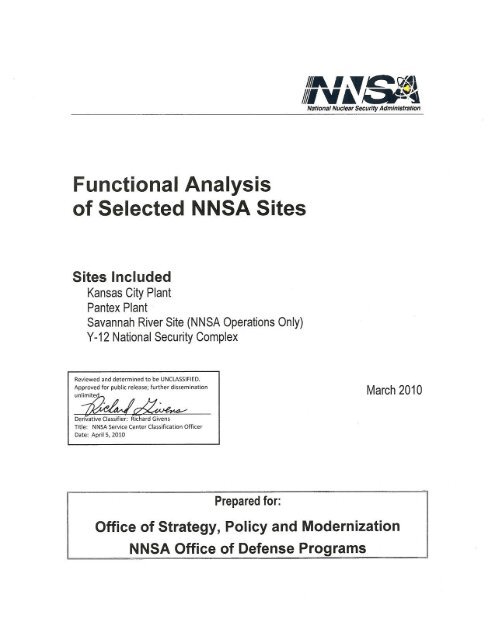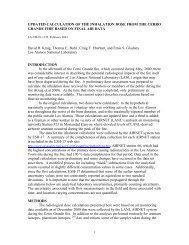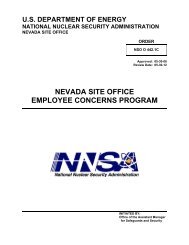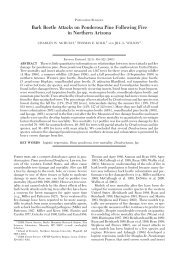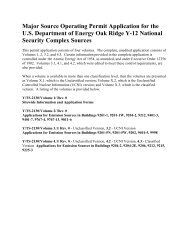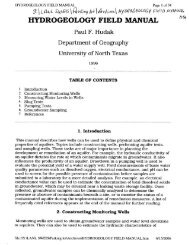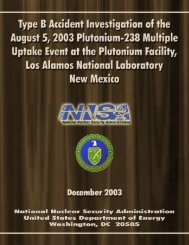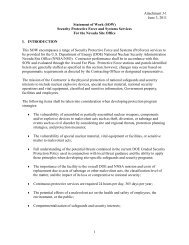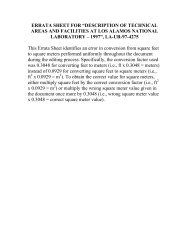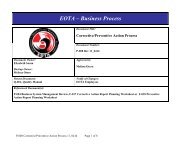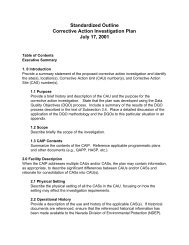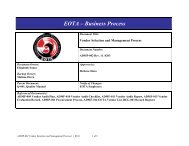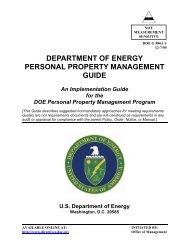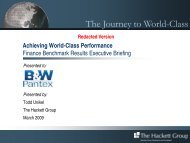Functional Analysis of Selected NNSA Sites - National Nuclear ...
Functional Analysis of Selected NNSA Sites - National Nuclear ...
Functional Analysis of Selected NNSA Sites - National Nuclear ...
Create successful ePaper yourself
Turn your PDF publications into a flip-book with our unique Google optimized e-Paper software.
<strong>Functional</strong> <strong>Analysis</strong><strong>of</strong> <strong>Selected</strong> <strong>NNSA</strong> <strong>Sites</strong>March 2010TABLE OF CONTENTS1.0 Introduction and Background............................................................................................... 41.1 Purpose <strong>of</strong> this <strong>Functional</strong> <strong>Analysis</strong> Update............................................................... 41.2 Scope ........................................................................................................................ 41.3 Approach ................................................................................................................... 41.4 Limitation and Constraints ......................................................................................... 52.0 <strong>Functional</strong> Hierarchy............................................................................................................ 73.0 Transition from Current to Future State ............................................................................. 274.0 Interfaces........................................................................................................................... 275.0 Information Flow Across the Enterprise ............................................................................. 325.1 Information/Documents Flow Across the NSE - Current State................................. 325.2 Information Technology (IT) Applications / Systems - Current State........................ 335.3 Applications within Information Technology (IT) Systems Grouping ........................ 396.0 Work Performed Outside Defense Programs .................................................................... 427.0 References ........................................................................................................................ 44Appendix A – Glossary <strong>of</strong> Terms and Acronyms ............................................................................ 45Appendix B – Approach Used......................................................................................................... 55Page 2 <strong>of</strong> 56
<strong>Functional</strong> <strong>Analysis</strong><strong>of</strong> <strong>Selected</strong> <strong>NNSA</strong> <strong>Sites</strong>March 2010LIST OF FIGURESFigure 1 – SRS Federal Reporting Structure .................................................................................... 6Figure 2 – SRS Contractor Reporting Structure................................................................................ 6Figure 3 – Top Level <strong>Functional</strong> Hierarchy and <strong>Functional</strong> Cost Activity Grouping .......................... 8Figure 4 –<strong>Functional</strong> Hierarchy Diagram – <strong>Nuclear</strong> Weapons Stewardship ..................................... 9Figure 5 –Hierarchy Diagram – Naval Reactors Stewardship......................................................... 10Figure 6 –<strong>Functional</strong> Hierarchy Diagram – <strong>Nuclear</strong> Nonproliferation.............................................. 11Figure 7 –<strong>Functional</strong> Hierarchy Diagram – Manage Work & Site Stewardship............................... 12Figure 8 – Current State External Interface Diagram, Physical Items - KCP .................................. 28Figure 9 – Current State External Interface Diagram, Physical Items - PX..................................... 29Figure 10 – Current State External Interface Diagram, Physical Items - SRS ................................ 30Figure 11 – Current State External Interface Diagram, Physical Items – Y-12. .............................. 31Figure 12 – Information Processing ................................................................................................ 32Figure 13 – Current State Information Interface Diagram – Product/Technical Aspect................... 34Figure 14 – Current State Information Interface Diagram – Business/Administrative Aspect ......... 35Figure 15 – Overview <strong>of</strong> Information Technology System .............................................................. 36LIST OF TABLESTable 1 – Function Listing, Definitions and Performing <strong>Sites</strong>.......................................................... 13Table 2 - Product / Technical Aspect - IT Applications ................................................................... 40Table 3 - Business / Administrative Aspect - IT Applications .......................................................... 41Table 4 – Estimated Revenue from Work for Others ...................................................................... 42Table 5 – Work for Other Agencies................................................................................................. 42Page 3 <strong>of</strong> 56
<strong>Functional</strong> <strong>Analysis</strong><strong>of</strong> <strong>Selected</strong> <strong>NNSA</strong> <strong>Sites</strong>March 20101.0 Introduction and BackgroundA very thorough functional analysis was completed for the <strong>Nuclear</strong> Security Enterprise (NSE) inSeptember 2007 (Reference 1). Since the completion <strong>of</strong> that study, the NSE has been undergoingchanges that were thought to be significant enough to warrant an update and revalidation <strong>of</strong> the2007 study. In particular, key decision documents 1 2 have been issued after the publication <strong>of</strong> theSupplemental Programmatic Environmental Impact Statement (Reference 2).1.1 Purpose <strong>of</strong> this <strong>Functional</strong> <strong>Analysis</strong> UpdateThe contracts for Pantex (PX), Y-12, and the Kansas City Plant (KCP) expire towards the end <strong>of</strong>2010. In support <strong>of</strong> the <strong>NNSA</strong> NSE Acquisition Strategy for these contracts, an interim update toReference 1 was considered necessary because <strong>of</strong> the changes that have occurred withtransforming the weapons complex enterprise. Savannah River Site (SRS) Tritium Operationswas also included even though the overall site contract had recently been re-competed. Theadditional information for Tritium was easier to obtain because <strong>of</strong> the clause placed in the currentcontract, administered by the Environmental Management (EM) Program, for the Managementand Operating contractor to complete a “severability” study to understand the actions needed totransfer Tritium to a separate <strong>NNSA</strong> contract.The update is intended be provided to potential bidders as supplemental information to thestatement <strong>of</strong> work that would be contained in the Request for Proposals for potential competition<strong>of</strong> the plant contracts. As time allows, a similar update will be conducted for Sandia <strong>National</strong>Laboratory (SNL), Los Alamos <strong>National</strong> Lab (LANL), Lawrence Livermore <strong>National</strong> Laboratory(LLNL), and the Nevada Test site (NTS). The culmination <strong>of</strong> the entire effort would then bepublished in a full revision to Reference 1.1.2 ScopeThe scope <strong>of</strong> this updated report is to revalidate the functions and interfaces described inReference 1 for PX, Y-12, KCP, and SRS Tritium Operations. This report also expands theevaluation <strong>of</strong> functions related to nuclear nonproliferation, Naval Reactors propulsion programs,and Work for Others and provides a much more detailed evaluation for information flow andinterfaces, an area given only cursory attention in Reference 1.1.3 ApproachThe approach used to revalidate the functions and interfaces described in Appendix B.1 Documentation includes the following : Department <strong>of</strong> Energy Record <strong>of</strong> Decision for the Complex Transformation Supplemental Programmatic Environmental ImpactStatement—Operations Involving Plutonium, Uranium, and the Assembly and Disassembly <strong>of</strong> <strong>Nuclear</strong> Weapons – December 19, 2008 Department <strong>of</strong> Energy Record <strong>of</strong> Decision for the Complex Transformation Supplemental Programmatic Environmental ImpactStatement—Tritium Research and Development, Flight Test Operations, and Major Environmental Test Facilities – December 19, 20082<strong>NNSA</strong> <strong>Nuclear</strong> Security Enterprise Acquisition Strategy, April 30, 2009Page 4 <strong>of</strong> 56
<strong>Functional</strong> <strong>Analysis</strong><strong>of</strong> <strong>Selected</strong> <strong>NNSA</strong> <strong>Sites</strong>March 20101.4 Limitation and ConstraintsRelative Magnitude <strong>of</strong> Functions Not Assessed: This review did not examine the relativemagnitude <strong>of</strong> scope or cost associated with the functions that are performed at multiple sites. Insome cases, the difference in magnitude is extremely high.Impacts <strong>of</strong> Missing Information: Two documents that have not been issued at the completion <strong>of</strong>this update are a potential ROD for Hydrodynamic Testing and High Explosives Research andDevelopment (R&D) and the 2009 <strong>Nuclear</strong> Posture Review (NPR). This review did not assume aposition with respect to these documents but the analysis is expected to be consistent with futuredirections for each.Performance Requirements Not Identified: This analysis focused on functions, which definewhat must be done. Without linking functions with the associated performance requirements, whichdefine how well the functions must be performed, it is not possible to understand impacts to theNSE mission.An example <strong>of</strong> the need to understand performance requirements is impacts on Infrastructure.Relocation <strong>of</strong> functions will impact infrastructure at the donor and recipient sites. Donor sites willincur new decommissioning and demolition requirements, and recipient sites would likely have tomodify the infrastructure utilities capacity (e.g., electricity, water, steam, waste treatment, additionalspace in existing buildings, etc).Landlord-Tenant Relationships: DP activities are performed at various Department <strong>of</strong> Energy(DOE) sites and site operations (landlord) are typically an <strong>NNSA</strong> responsibility. The SavannahRiver Site (SRS) tritium activity for DP is unique relative to this relationship because it isautonomously operated at an Environmental Management (EM) Program site. There, <strong>NNSA</strong> is inthe role <strong>of</strong> tenant. The functional review did not make a distinction relative to “funding”responsibility <strong>of</strong> the function, only that the function was conducted at the site; however, all <strong>NNSA</strong>work at the site is funded by <strong>NNSA</strong>. The nuclear nonproliferation functions (Function C) areconducted at SRS, but are not the direct responsibility <strong>of</strong> the local <strong>NNSA</strong> Site Office, although theSite Office does provide contracting, legal, Environmental, Safety & Health (ES&H), and otherlogistical support.Figure 1 depicts the reporting structure at the site at the federal level. Figure 2 shows the reportingstructure at the site level.Page 5 <strong>of</strong> 56
<strong>Functional</strong> <strong>Analysis</strong><strong>of</strong> <strong>Selected</strong> <strong>NNSA</strong> <strong>Sites</strong>March 2010Department <strong>of</strong>EnergyDepartment <strong>of</strong>Agriculture<strong>National</strong> <strong>Nuclear</strong>SecurityAdministration(<strong>NNSA</strong>)NA-1Office <strong>of</strong>EnvironmentalManagement(EM)Defense <strong>Nuclear</strong> NonproliferationFissile Materials DispositionNA-26Defense Programs – Headquarters(DP-HQ)NA-10Office <strong>of</strong> SecureTransportation(OST)NA-15<strong>Nuclear</strong> Safety &OperationsNA-17Office <strong>of</strong> Site Engineering /Construction ManagementSavannah River Site Office(SRSO)EM – Savannah RiverOperations OfficeUSDAForest Service -Savannah RiverLegendMatrix ReportingNA-262Figure 1 – SRS Federal Reporting StructureOffice <strong>of</strong> Site Engineering /Construction Management<strong>NNSA</strong> - DPSavannah River Site Office(SRSO)EM – Savannah RiverOperations OfficeURS CorporationPDCF DesignShaw AREVAMOXBaker ConcreteConstruction, IncWSB ConstructionSavannah River <strong>Nuclear</strong> SolutionsM&O ServicesSavannah River <strong>National</strong> LaboratoryTechnical Services<strong>NNSA</strong> ServicesTritium PDC Construction WBSPU / U Processing& StorageSavannah RiverRemediationLiquid WasteWackenhutServices Inc.Security ServicesParsonsSalt Waste Processingand Tank ClosuresUSDA ForestService -SavannahRiverFigure 2 – SRS Contractor Reporting StructureUniversity <strong>of</strong> Georgia -Savannah River Ecology Laboratory<strong>National</strong> Environmental ResearchParkPage 6 <strong>of</strong> 56
<strong>Functional</strong> <strong>Analysis</strong><strong>of</strong> <strong>Selected</strong> <strong>NNSA</strong> <strong>Sites</strong>March 20102.0 <strong>Functional</strong> HierarchyThe original 2007 function listing was used as the starting baseline for this update. Since itsissuance a number <strong>of</strong> key decisions have been made and include: SPEIS (DOE-EIS 0236-S4) Records <strong>of</strong> Decisiono Operations Involving Plutonium, Uranium, and the Assembly and Disassembly <strong>of</strong><strong>Nuclear</strong> Weapons – December 19, 2008o Tritium Research and Development, Flight Test Operations, and Major EnvironmentalTest Facilities – December 19, 2008o Continued Operations at various sites Congressional Language for Tritium Research and Development (R&D) <strong>NNSA</strong> <strong>Nuclear</strong> Security Enterprise Acquisition Strategy <strong>Functional</strong> <strong>Analysis</strong> by SITS (2009) for the Corporate Physical Infrastructure Business Plan NWC Work Breakdown System (draft) Ten Year Site Plans (2009-2018) Information Technology (IT) Optimization StudiesThe 2007 hierarchy was structured around the <strong>NNSA</strong>-Defense Programs weapons productionactivities, i.e. mission direct activities. As functions for other <strong>NNSA</strong> missions were further defined,the need to revise the hierarchical layout was assessed. Alignment with the DOE’s Chief FinancialOfficer’s (CFO) Office <strong>of</strong> Internal Review’s Report on <strong>Functional</strong> Support Cost Activities wasdetermined to be a prudent approach to relate the functional hierarchy with the categories used inthe cost activity report. The Office <strong>of</strong> the CFO is responsible for coordinating and assembling theDepartment's Support Cost by <strong>Functional</strong> Activity information. Support cost activities are thosenecessary functions that enable the Department to accomplish direct mission activities. Supportcosts are allocated into twenty-two distinct categories, such as procurement, maintenance andsafety and health. This schema provides a means to more easily identify the cost <strong>of</strong> a function.Figure 3 is a diagram that shows the top level <strong>of</strong> the NSE functional hierarchy and correlates theCFO’s existing cost activity structure with the functional hierarchy.Figures 4 through 7 provide hierarchy diagrams for each top level functions. Definitions <strong>of</strong> the tier 1and 2 functions are provided in Table 1 along with a list <strong>of</strong> functions for the entire hierarchy thatidentifies performing sites 3 for each. Detail information and definitions relative to the CFO costactivity structure can be found on their web site (Reference 3).3 Performing Site: Refers to the home site <strong>of</strong> the personnel performing the function, regardless <strong>of</strong> their physical location. Some"sites" (e.g., SNL) exist in multiple locations (e.g., Albuquerque, NM; Livermore, CA; and Amarillo, TX), and some sites'personnel perform NSE functions at other NSE sites.Page 7 <strong>of</strong> 56
<strong>Functional</strong> <strong>Analysis</strong><strong>of</strong> <strong>Selected</strong> <strong>NNSA</strong> <strong>Sites</strong>March 2010F.0Protect<strong>National</strong><strong>Nuclear</strong> SecurityAProvide <strong>Nuclear</strong>WeaponStewardshipBProvide NavalReactorStewardshipCProvide<strong>Nuclear</strong> NonProliferationMission DirectCosts incurred to directly accomplish the Department's missionDManageWork &Site Stewardship<strong>Functional</strong> Support CostCapital / Construction CostCost related to Line Items,Capital Equipment and General Plant ProjectsMission SupportCosts that exist solely due to theunique mission being accomplished.General SupportCosts which would exist regardless <strong>of</strong>the specific mission.Site Specific SupportCosts not defined as general support,mission support or constructionFigure 3 – Top Level <strong>Functional</strong> Hierarchy and <strong>Functional</strong> Cost Activity GroupingPage 8 <strong>of</strong> 56
<strong>Functional</strong> <strong>Analysis</strong><strong>of</strong> <strong>Selected</strong> <strong>NNSA</strong> <strong>Sites</strong>March 2010AProvide<strong>Nuclear</strong>WeaponStewardshipA.1A.2A.3A.4A.5A.6Provide <strong>Nuclear</strong>WeaponsValidateWeaponCertificationProvide SecureTransportationStore <strong>Nuclear</strong>Weapons &MaterialsDevelop/MaintainScience,Engineering, &Technology BaseMaintainUndergroundTest CapabilityA.1.1Design/DevelopWeaponA.2.1PerformStockpileEvaluationsA.3.1Package <strong>Nuclear</strong>Weapons,Components, andMaterialsA.4.1StageWeaponsA.5.1PerformWeaponResearch &DevelopmentA.6.1MaintainUndergroundTesting PhysicalAssets /EquipmentA.1.2Produce FirstProductionUnit (FPU) andWeaponsA.2.2AssessReliability <strong>of</strong>Weapon TypesA.3.2Move <strong>Nuclear</strong>Weapons,Components,and MaterialsA.4.2StoreWeaponComponentsand MaterialsA.5.2ConductResearch &DevelopmentTestingA.6.2Develop TestObject/DeviceAuthorizationBasesA.1.3A.2.3A.3.3A.4.3A.5.3A.6.3DevelopAuthorizationBases (AB)DevelopBaselineModelsDevelopTransportationAuthorizationBasesAccount &ControlComponents& MaterialsDevelop/MaintainPredictiveCapabilitiesMaintainUndergroundTestingDiagnosticsA.1.4Conduct ProcessHazardsAnalyses forFacilitiesA.2.4Assess Margins/ UncertaintiesA.3.4MaintainTransportationSafety & SecurityProgramsA.5.4Develop/MaintainNew/ImprovedProductionCapabilitiesA.6.4MaintainPersonnelKnowledgeBaseA.2.5A.3.5A.5.5ConductMaterials /Component /System TestsMaintainTransportationFleetDevelop/MaintainNew/ImprovedTesting/DiagnosticCapabilitiesA.2.6A.5.6CompleteAnnualAssessmentIntegrateValidatedCapabilities intoApplicationsFigure 4 –<strong>Functional</strong> Hierarchy Diagram – <strong>Nuclear</strong> Weapons StewardshipPage 9 <strong>of</strong> 56
B<strong>Functional</strong> <strong>Analysis</strong><strong>of</strong> <strong>Selected</strong> <strong>NNSA</strong> <strong>Sites</strong>March 2010ProvideNaval ReactorsStewardshipB.1Provide EnrichedUranium (EU)FeedstockB.2MoveMaterialB.3Dismantle &DispositionMaterialB.1.1B.2.1Prepare MaterialManagementStrategy PlanB.1.2Conduct MaterialCharacterizationB.2.2PackageMaterialShipMaterialB.1.3ProcessMaterialB.1.4StoreMaterialFigure 5 –Hierarchy Diagram – Naval Reactors StewardshipPage 10 <strong>of</strong> 56
<strong>Functional</strong> <strong>Analysis</strong><strong>of</strong> <strong>Selected</strong> <strong>NNSA</strong> <strong>Sites</strong>March 2010CProvide<strong>Nuclear</strong>NonproliferationC.1C.2C.3C.4C.5Detect and DeterIllicit International<strong>Nuclear</strong> TransfersConductResearch andDevelopmentSecure <strong>Nuclear</strong>and RadiologicalMaterialsPromoteInternationalNonproliferationRegimesEliminateWeapons-UsableMaterialC.1.1Control ExportLicensing <strong>of</strong><strong>Nuclear</strong> Material,Equipment &TechnologyC.2.1InvestigateForeignWeapons <strong>of</strong>Mass DestructionC.3.1Account for<strong>Nuclear</strong> andRadiologicalMaterialsC.4.1CounteractTraffickingand <strong>Nuclear</strong>TerrorismC.5.1RemoveMaterialC.1.2C.2.2C.3.2C.4.2C.5.2SolicitInternationalExport Control <strong>of</strong><strong>Nuclear</strong> Material,Equipment andTechnologyC.1.3RedirectScientificEngagementandTechnologiesDevelopTechnologiesto Detect andMonitor WMDC.2.3Develop<strong>Nuclear</strong>DetonationDetectionTechnologiesControl<strong>Nuclear</strong> andRadiologicalMaterialsC.3.3Protect<strong>Nuclear</strong> andRadiologicalMaterialsC.3.4EducateInternationalTradesCommunityC.4.3RegulateInternationalStandards &PolicyConvertMaterialC.5.3Dispose <strong>of</strong>MaterialRespondtoEmergenciesFigure 6 –<strong>Functional</strong> Hierarchy Diagram – <strong>Nuclear</strong> NonproliferationPage 11 <strong>of</strong> 56
<strong>Functional</strong> <strong>Analysis</strong><strong>of</strong> <strong>Selected</strong> <strong>NNSA</strong> <strong>Sites</strong>March 2010DManageWork &SiteStewardshipD.1D.2D.3ProvideMissionSupportProvideGeneralSupportProvideSite SpecificSupportD.1.1Provide Fac ilities& EquipmentD.1.2Provide FacilitySafeguards &SecurityD.2.1Provide CentralAdministrativeServicesD.2.2Manage HumanResourcesD.3.1ManageLDRD/PDRDProgram WorkActivitiesD.3.2Manage Workfor OthersActivitiesD.1.3ImplementRequirementsforEnvironmental,Safety, & HealthD.1.4Provide Logistics& QualityAssuranceServicesD.1.5D.2.3ManageInformationD.2.4ProcureMaterials &ServicesD.3.3Control General& AdministrativeManagementActivitiesD.3.4AdministerTaxesAssociated withSite OperationsProvideUtilitiesD.1.6Respond toEmergenciesFigure 7 –<strong>Functional</strong> Hierarchy Diagram – Manage Work & Site StewardshipPage 12 <strong>of</strong> 56
F.0ATable 1 – Function Listing, Definitions and Performing <strong>Sites</strong><strong>Functional</strong> <strong>Analysis</strong><strong>of</strong> <strong>Selected</strong> <strong>NNSA</strong> <strong>Sites</strong>March 2010(Note: Performing sites are indicated only at the lowest level <strong>of</strong> functional decomposition. Higher levels are shaded gray.)List <strong>of</strong> <strong>Nuclear</strong> Security Enterprise FunctionsPerforming SiteAs <strong>of</strong> 2009/2010Function Number Function Title and Definition KCP PX SRS Y-12A.1A.1.1A.1.2Protect <strong>National</strong> <strong>Nuclear</strong> SecurityMaintain a credible and effective deterrent with the lowest possible level <strong>of</strong>nuclear weapons consistent with the national security and commitments/obligations to US allies.Provide <strong>Nuclear</strong> Weapon StewardshipSustain warheads for the indefinite future utilizing a science-basedStockpile Stewardship Program (SSP), which emphasizes developmentand application <strong>of</strong> greatly improved technical capabilities to assess thesafety, security, and reliability <strong>of</strong> existing nuclear warheads without the use<strong>of</strong> nuclear testing.Provide <strong>Nuclear</strong> WeaponsDevelop, produce, maintain, and dispose nuclear weapons in accordancewith the D&P Manual Phase 1-7 and 6.X processes to includemaintaining the capability to design, manufacture, and certify newwarheads; conducting routine maintenance and repair; dismantling retiredweapons; and refurbishing warheads.Design/Develop WeaponConceive, plan, and realize full scale production capabilities for themanufacture <strong>of</strong> a first production unit (FPU) <strong>of</strong> a nuclear weapon type.Activities include pre-production design (i.e. conceptualization, analysis,research, specification and requirement), production development, situtesting and certification processing.A.1.1.1 Develop Weapon Concept No No No NoA.1.1.2 Develop Weapon Feasibility/Design Definition No No No NoA.1.1.3Perform Development EngineeringA.1.1.3.1 Perform Detailed Component/Assembly Design No No No NoA.1.1.3.2 Perform Material Studies Yes Yes Yes YesA.1.1.3.3 Conduct Modeling & Simulation Analyses Yes No Yes NoA.1.1.4Perform Production EngineeringA.1.1.4.1 Develop Production Concepts Yes Yes Yes YesA.1.1.4.2 Develop Production Process Yes Yes Yes YesA.1.1.4.3 Develop Full Production Capabilities Yes Yes Yes YesA.1.1.4.4 Develop Tooling/Gauging for Weapon Assembly Yes Yes Yes YesA.1.1.5Conduct Validation & Verification (V&V) TestingA.1.1.5.1 Conduct V&V Assembly Level Testing Yes Yes Yes NoA.1.1.5.2 Conduct V&V Component Level Testing Yes Yes Yes YesA.1.1.6 Certify Weapon No No No NoA.1.2.1A.1.2.1.1Produce First Production Unit (FPU) & WeaponsMonitor and manage the life cycle stages <strong>of</strong> a weapon type frommanufacture to disposal, including the data and information flowassociated with the overall life- cycle process.Manufacture Weapon & AssembliesProcess Materials for Weapons ProductionA.1.2.1.1.1 Process Plutonium No No No NoA.1.2.1.1.2 Process Beryllium No No No YesPage 13 <strong>of</strong> 56
List <strong>of</strong> <strong>Nuclear</strong> Security Enterprise Functions<strong>Functional</strong> <strong>Analysis</strong><strong>of</strong> <strong>Selected</strong> <strong>NNSA</strong> <strong>Sites</strong>March 2010Performing SiteAs <strong>of</strong> 2009/2010Function Number Function Title and Definition KCP PX SRS Y-12A.1.2.1.1.3 Process & Recover Lithium No No No YesA.1.2.1.1.4Obtain & Process TritiumA.1.2.1.1.4.1 Extract Tritium from TPBARs No No Yes NoA.1.2.1.1.4.2 Unload Tritium from Reservoirs No No Yes NoA.1.2.1.1.4.3 Process Tritium No No Yes NoA.1.2.1.1.5Process Highly Enriched Uranium (HEU)A.1.2.1.1.5.1 Recover HEU No No No YesA.1.2.1.1.5.2 Fabricate HEU No No No YesA.1.2.1.1.6Process Depleted UraniumA.1.2.1.1.6.1 Fabricate Depleted Uranium No No No YesA.1.2.1.1.6.2 Fabricate U6 Nb No No No YesA.1.2.1.1.7Produce/Obtain/Process ExplosivesA.1.2.1.1.7.1 Synthesize Explosives No Yes No NoA.1.2.1.1.7.2 Formulate Explosives No Yes No NoA.1.2.1.1.7.3 Procure Explosives No Yes No NoA.1.2.1.1.7.4 Press Explosives No Yes No NoA.1.2.1.1.7.5 Machine Explosives No Yes No NoA.1.2.1.1.7.6 Inspect/Test/Qualify Explosives No Yes Yes NoA.1.2.1.1.7.7 Dispose <strong>of</strong> Explosives (production residues) Yes Yes Yes NoA.1.2.1.1.8 Produce/Obtain Specialized Materials Yes No Yes YesA.1.2.1.2Manufacture Primary ComponentsA.1.2.1.2.1 Produce Main Charge Assembly No Yes No NoA.1.2.1.2.2 Manufacture Pits No No No NoA.1.2.1.2.3 Produce Other Primary Components No No No YesA.1.2.1.2.4 Re-qualify & Reaccept Pits for Reuse No Yes No NoA.1.2.1.3Manufacture Secondary ComponentsA.1.2.1.3.1 Produce HEU Components No No No YesA.1.2.1.3.2 Produce & Recover Lithium Components No No No YesA.1.2.1.3.3 Produce Depleted Uranium Components No No No YesA.1.2.1.3.4 Produce Aluminum Alloy Components No No No YesA.1.2.1.3.5 Produce Special Components No No No YesA.1.2.1.3.6 Produce Stainless Steel Can No No No YesA.1.2.1.3.7 Assemble Canned Sub Assemblies No No No YesA.1.2.1.3.8 Manufacture Radiation Cases No No No YesA.1.2.1.3.9 Assemble Limited Life Component (LLC) Kits No No No YesA.1.2.1.2.10 Recertify & Re-qualify CSA for Reuse No Yes No YesA.1.2.1.4Produce Gas Transfer AssemblyA.1.2.1.4.1 Prepare Reservoirs No No Yes NoA.1.2.1.4.2Load ReservoirsA.1.2.1.4.2.1 Fill with Tritium Gas No No Yes NoA.1.2.1.4.2.2 Fill with Other Gases (Non-Radioactive) No No Yes NoA.1.2.1.4.3 Finish Reservoirs No No Yes NoA.1.2.1.4.4 Assemble Limited Life Component (LLC) Kits No No Yes NoA.1.2.1.5 Manufacture Energetic Assemblies No No No NoPage 14 <strong>of</strong> 56
List <strong>of</strong> <strong>Nuclear</strong> Security Enterprise Functions<strong>Functional</strong> <strong>Analysis</strong><strong>of</strong> <strong>Selected</strong> <strong>NNSA</strong> <strong>Sites</strong>March 2010Performing SiteAs <strong>of</strong> 2009/2010Function Number Function Title and Definition KCP PX SRS Y-12A.1.2.1.6Manufacture/Supply Non-nuclear Assemblies &ComponentsA.1.2.1.6.1 Manufacture/Supply Engineered Materials Yes No No YesA.1.3A.1.2.1.6.2 Manufacture/Supply Machined Parts/Assemblies Yes No No YesA.1.2.1.6.3 Manufacture/Supply Electrical/Electronic Assemblies Yes No No NoA.1.2.1.6.4 Manufacture/Supply Specialized Equipment Yes Yes No NoA.1.2.1.6.5 Manufacture/Supply Neutron Generators (NG) No No No NoA.1.2.1.6.6 Assemble Limited Life Component (LLC) Kits Yes No No NoA.1.2.2 Assemble Weapons No Yes No NoA.1.2.3Disassemble WeaponsA.1.2.3.1 Disassemble Weapon Into Assemblies No Yes No NoA.1.2.3.2 Disassemble Weapon Assemblies Into Components Yes Yes No YesA.1.2.4Maintain Weapons in FieldA.1.2.4.1 Replace Limited Life Components (LLC) No Yes No NoA.1.2.4.2 Perform Routine Maintenance No Yes No NoA.1.2.4.3 Implement Corrective Actions No Yes No NoA.1.2.4.4Maintain Weapon ComponentsA.1.2.4.4.1 Perform Routine Maintenance Yes Yes Yes NoA.1.2.4.4.2 Implement Corrective Actions Yes Yes Yes NoA.1.2.5 Refurbish Weapons (Alts/Mods) in Field Yes Yes No NoA.1.2.6Dismantle Production Returns / Waste / ByproductsA.1.2.6.1 Characterize Components & Materials Yes Yes Yes YesA.1.2.6.2 Recover Components & Materials Yes Yes Yes YesA.1.2.6.3Recycle Components & MaterialsA.1.2.6.3.1 Produce Helium-3 No No Yes NoA.1.2.6.3.2 Produce Other Products/Materials for Reuse Yes Yes No YesA.1.2.6.4 Demilitarize Components & Materials Yes Yes Yes YesA.1.2.6.5 Dispose <strong>of</strong> Components & Materials Yes Yes Yes YesA.1.2.7Provide Military Liaison/Intra-Interagency SupportA.1.2.7.1 Provide Hardware & S<strong>of</strong>tware Support Yes Yes Yes NoA.1.2.7.2 Provide Assessment Support No Yes Yes NoDevelop Authorization Bases (AB)Determine, document and maintain the composite <strong>of</strong> information,which comprise a facility design basis and operational requirements,submitted to, and accepted by, DOE that responds to radiological,nuclear, and process safety requirements considered to be important tothe safety <strong>of</strong> the operation.A.1.3.1 Develop Manufacturing AB for <strong>Nuclear</strong> Facilities No Yes Yes YesA.1.3.2 Develop Weapon Assembly/Disassembly AB No Yes No NoA.1.4Conduct Process Hazardous Analyses (PHA) for Facilities (<strong>Nuclear</strong>& Non-<strong>Nuclear</strong>)Perform assessments directed toward analyzing potential causes andconsequences <strong>of</strong> fires, explosions, releases <strong>of</strong> toxic or flammablechemicals and major spills <strong>of</strong> hazardous chemicals, and it focuses onequipment, instrumentation, utilities, human actions, and externalfactors that might impact the process.Yes Yes Yes YesPage 15 <strong>of</strong> 56
List <strong>of</strong> <strong>Nuclear</strong> Security Enterprise Functions<strong>Functional</strong> <strong>Analysis</strong><strong>of</strong> <strong>Selected</strong> <strong>NNSA</strong> <strong>Sites</strong>March 2010Performing SiteAs <strong>of</strong> 2009/2010Function Number Function Title and Definition KCP PX SRS Y-12A.2Validate Weapon CertificationConduct weapon, component, and system testing and perform analysesto ensure the vitality, safety, and readiness <strong>of</strong> the nuclear weaponsstockpile.A.2.1Perform Stockpile EvaluationsConduct extensive and rigorous tests to evaluate the portions andcomponents <strong>of</strong> the stockpile weapons to provide indicators <strong>of</strong>constancy through comparison with baseline data gathered duringweapon development and production. Stockpile Evaluation includesnew material laboratory tests, new material flight tests, stockpilelaboratory tests, stockpile flight tests, quality evaluations, specialtesting, and surveillance <strong>of</strong> weapon systems to support assessment <strong>of</strong>the safety and reliability <strong>of</strong> the nuclear weapons stockpile and toconfirm that design choices did not cause problems.A.2.1.1 Develop Stockpile Evaluation Requirements No No No NoA.2.1.2Perform Weapon & Component SurveillanceA.2.1.2.1 Determine Statistical Sample Size No No No NoA.2.1.2.2 Conduct Disassembly & Inspections (D&I) No Yes No YesA.2.1.2.3Conduct Surveillance <strong>of</strong> Assembly/Component EvaluationTests (Shake-Rattle-Roll Testing)Yes Yes Yes YesA.2.1.2.4 Build Joint Test Assemblies / JTA Sub-Assemblies Yes Yes Yes YesA.2.1.2.5Confirm <strong>Nuclear</strong> Explosive-Like Assembly (NELA) status asa Test ArticleA.2.1.2.5.1 Build Test Beds No Yes No NoA.2.1.2.5.2 Evaluate Test Beds No Yes No NoA.2.1.2.5.3 Disassemble Test Beds No Yes No NoA.2.1.2.5.4 Ship & Test Quality Evaluation Test (QET) Parts No Yes No NoA.2.1.2.6Conduct Stockpile TestsA.2.1.2.6.1 Conduct Stockpile Laboratory Tests (SLT) No Yes Yes NoA.2.1.2.6.2 Conduct Stockpile Flight Tests No No No NoA.2.1.2.6.3Conduct Joint Integrated Laboratory Tests (JILTs) withDoDNo Yes No NoA.2.1.2.7 Perform Post Mortem Evaluation Yes Yes Yes YesA.2.1.3 Perform Aging Assessments Yes No Yes YesA.2.1.4Assess AnomaliesA.2.1.4.1 Collect Data No Yes Yes YesA.2.1.4.2 Evaluate Results No Yes No NoA.2.2A.2.3Assess Reliability <strong>of</strong> Weapon TypesProvide a quantitative metric that reflects the ability <strong>of</strong> a weapon toperform its intended function successfully. A weapon’s reliability is theprobability <strong>of</strong> achieving the specified yield, at the target, across theStockpile-To-Target Sequence <strong>of</strong> environments, throughout theweapon’s lifetime, assuming proper inputs.Develop Baseline ModelsDevelop baseline models that provide accurate simulations <strong>of</strong> devicebehavior outside the parameter space spanned by the underground testdata.No No No NoNo No No NoPage 16 <strong>of</strong> 56
List <strong>of</strong> <strong>Nuclear</strong> Security Enterprise Functions<strong>Functional</strong> <strong>Analysis</strong><strong>of</strong> <strong>Selected</strong> <strong>NNSA</strong> <strong>Sites</strong>March 2010Performing SiteAs <strong>of</strong> 2009/2010Function Number Function Title and Definition KCP PX SRS Y-12A.2.4Assess Margins/UncertaintiesConduct evaluations <strong>of</strong> the reliability <strong>of</strong> the nuclear weapon systemsand determine the confidence that can be placed in estimates <strong>of</strong> thatreliability on the performance thresholds and associated margins forengineered systems that are made under conditions <strong>of</strong> uncertainty forthe nuclear weapons stockpile, in light <strong>of</strong> the test moratorium. Explorehow quantification <strong>of</strong> margins and uncertainties (QMU) methodologymay evolve to meet future needs.No No No NoConduct Materials/Component/Assembly TestsA.2.5Analyze the physical and chemical characteristics <strong>of</strong> materials,components and systems against Design Authority weapons specificspecificationA.2.5.1 Conduct Material Testing No Yes No YesA.2.5.2 Conduct Component Testing No Yes No YesA.2.5.3 Conduct Assembly Testing No Yes No NoA.2.6Complete Annual AssessmentPerform annual formalized reviews, utilizing wide range <strong>of</strong> processes,technologies, and expertise, culminating in a written certification letterfrom the Secretaries <strong>of</strong> Defense and Energy to the President that thenuclear weapons stockpile is safe and reliable in the absence <strong>of</strong>underground testing, and provides a measure <strong>of</strong> confidence that thenuclear deterrent is still safe and militarily effective.No No No NoA.3A.3.1Provide Secure TransportationProvide the resources to safely and securely transport nuclear weapons,weapons components, and special nuclear materials to meet projectedDOE, DoD, and other customer requirements.Package <strong>Nuclear</strong> Weapons, Components & MaterialsPackage nuclear weapons, weapons components, and special nuclearmaterials in accordance with current requirements.Yes Yes Yes YesA.3.2A.3.2.1A.3.2.1.1Move <strong>Nuclear</strong> Weapons, Components, & MaterialsSchedule and securely transport nuclear weapons, weaponscomponents, and special nuclear materials in accordance to customerrequirements and federal/state regulations.Coordinate Shipments for Off-site MovementSchedule ShipmentsA.3.2.1.1.1 Schedule Weapon Shipments No No No NoA.3.2.1.1.2 Schedule Component Shipments Yes Yes Yes YesA.3.2.1.1.3 Schedule Other Materials Shipments (Category III or less) No Yes No YesA.3.2.1.2 Control Shipments No Yes No NoA.3.2.2 Transport Weapon No No No NoA.3.2.3 Transport Weapon Components Yes Yes Yes YesA.3.2.4 Transport <strong>Nuclear</strong> Materials No Yes No NoA.3.2.5 Transport Other Materials (Category III or less) No Yes No YesA.3.2.6 Move Components & Materials On-Site Yes Yes Yes YesA.3.3Develop Transportation Authorization BasesDetermine, document and maintain the composite <strong>of</strong> information,submitted to, and accepted by, DOE that responds to radiological,nuclear, and process safety requirements considered to be important tothe safety <strong>of</strong> the operation.No Yes No YesPage 17 <strong>of</strong> 56
List <strong>of</strong> <strong>Nuclear</strong> Security Enterprise Functions<strong>Functional</strong> <strong>Analysis</strong><strong>of</strong> <strong>Selected</strong> <strong>NNSA</strong> <strong>Sites</strong>March 2010Performing SiteAs <strong>of</strong> 2009/2010Function Number Function Title and Definition KCP PX SRS Y-12A.3.4A.3.5A.3.5.1Maintain Transportation Safety & Security ProgramsProvide and implement efficient and effective business operations andintellectual property in support <strong>of</strong> <strong>NNSA</strong>'s mission.Maintain Transportation FleetProvide, maintain, modify and redesigned transport equipment toincorporate features that effectively enhance self protection and denyunauthorized access to the materials.Provide Transportation EquipmentNo Yes No YesA.3.5.1.1 Perform Vehicle Maintenance Yes Yes Yes YesA.3.5.1.2 Provide Vehicle Replacements Yes No Yes NoA.3.5.1.3 Maintain Aviation Services No No No NoA.3.5.1.4A.3.5.2Provide Safeguards Transporter (SGT)A.3.5.1.4.1 Design SGT/Components Yes No No NoA.3.5.1.4.2 Build SGT Yes No No NoA.3.5.1.4.3 Maintain SGT Yes Yes No NoProvide Storage/Transportation ContainersA.3.5.2.1 Research/Design Containers Yes Yes Yes YesA.3.5.2.2 Produce/Procure Containers Yes Yes Yes YesA.3.5.2.3 Certify Containers Yes Yes Yes YesA.3.5.2.4 Maintain Containers Yes Yes Yes YesA.3.5.2.5 Test/Evaluate Containers Yes Yes Yes YesA.3.5.2.6 Recertify & Requalify Containers for Reuse Yes Yes Yes YesA.3.5.2.7 Dispose <strong>of</strong> Containers Yes Yes No YesA.3.5.3Perform Office <strong>of</strong> Secure Transportation (OST) Logistics &TrainingYes No No NoA.3.5.3.1Conduct OST Training for Transportation, Logistic andOperationsYes No No NoStore <strong>Nuclear</strong> Weapons & MaterialsStore weapons and weapon materials at nuclear material facilities untilA.4deployed as spares, as a source <strong>of</strong> parts for remanufacture or themanufacture <strong>of</strong> other weapons, or held in reserve as a responsive forcethat may augment deployed forces.A.4.1Stage WeaponsTemporarily store nuclear weapons in accordance with DOE/DoDrequirements until requested to be a source <strong>of</strong> parts forNo Yes No Noremanufacture or the manufacture <strong>of</strong> other weapons, or held inreserve as a responsive force that may augment deployed forces.A.4.2Store <strong>Nuclear</strong> Weapons Components & MaterialsStore weapon components and nuclear materials in accordance withDesign Agency requirements until requested to be deployed as spares,as a source <strong>of</strong> parts for remanufacture or the manufacture <strong>of</strong> otherweapons, or held in reserve as a responsive force that may augmentdeployed forces.A.4.2.1 Develop <strong>Nuclear</strong> Material Storage Strategy/Plan No Yes Yes YesA.4.2.2 Store Bulk Plutonium 238 No No No NoA.4.2.3 Store Bulk Plutonium 239 No No No NoA.4.2.4 Store Uranium No No No YesA.4.2.5 Store Tritium No No Yes NoA.4.2.6 Store Special & Weapon Non-<strong>Nuclear</strong> Material Yes Yes Yes YesPage 18 <strong>of</strong> 56
List <strong>of</strong> <strong>Nuclear</strong> Security Enterprise Functions<strong>Functional</strong> <strong>Analysis</strong><strong>of</strong> <strong>Selected</strong> <strong>NNSA</strong> <strong>Sites</strong>March 2010Performing SiteAs <strong>of</strong> 2009/2010Function Number Function Title and Definition KCP PX SRS Y-12A.5A.4.2.7 Store Weapon Components Yes Yes Yes YesA.4.2.8 Store Lithium No No No YesA.4.3Account & Control Components & MaterialsControl <strong>of</strong> nuclear material inventory holdings, operations, and missionsto provide assurance that nuclear materials are accounted for properly,and detect and defer theft or diversion <strong>of</strong> nuclear materials orcomponents.A.4.3.1 Characterize Components & Materials Yes Yes Yes YesA.5.1A.4.3.2Manage Components & Materials in StorageA.4.3.2.1 Inventory Components & Materials Yes Yes Yes YesA.4.3.2.2 Account for Components & Materials in Inventory Yes Yes Yes YesDevelop/Maintain Science, Engineering, & Technology BaseConduct research and development, testing, and analyses <strong>of</strong> weaponsystems, components, and materials to enhance the understanding <strong>of</strong>weapons performance, science, and material properties. Develop andprovide the analytical tools to perform analyses. Develop enhanceddesign and production capabilities.Perform Weapon Research & DevelopmentIdentify, develop and deploy innovative new enabling technologies toimprove and provide required capabilities for weapon design,production and dismantlement needs. Technologies include bothphysical and computation techniques use as input for numericalmodeling.A.5.1.1Recreate Environment Within Weapon During ImplosionA.5.1.1.1Recreate Weapon Environment via Inertial ConfinementFusionNo No No NoA.5.1.1.2 Recreate Weapon Environment via Pulse Power No No No NoA.5.1.1.3A.5.1.2Recreate Weapon Environment via Large-ScaleHydrodynamic TestingModel/Simulate Weapon BehaviorNo No No NoA.5.1.2.1 Develop Computer Codes No No No NoA.5.1.2.2 Develop Computer Models No No No NoA.5.1.2.3 Validate Computer Codes/Models No No No NoA.5.1.2.4Provide Capability Platform (computers, hardware,interface)No No No NoA.5.1.2.5 Maintain Codes/Models for Users No No No NoA.5.1.2.6 Provide Visualization/Storage Capability No No No NoA.5.1.3 Investigate Hostile Environments No No No NoA.5.1.4Improve Weapon & Component PerformanceA.5.1.4.1 For HE Components No Yes No NoA.5.1.4.2 For Tritium Components No No Yes NoA.5.1.4.3 For Plutonium Components No No No NoA.5.1.4.4 For Uranium Components No No No YesA.5.1.4.5 For Non-<strong>Nuclear</strong> Components Yes No No YesA.5.1.4.6 For Lithium Components No No No YesA.5.1.5Improve Weapon Material CharacteristicsA.5.1.5.1 For HE Components No Yes No NoA.5.1.5.2 For Tritium Components No No Yes NoA.5.1.5.3 For Plutonium Components No No No NoPage 19 <strong>of</strong> 56
List <strong>of</strong> <strong>Nuclear</strong> Security Enterprise Functions<strong>Functional</strong> <strong>Analysis</strong><strong>of</strong> <strong>Selected</strong> <strong>NNSA</strong> <strong>Sites</strong>March 2010Performing SiteAs <strong>of</strong> 2009/2010Function Number Function Title and Definition KCP PX SRS Y-12A.5.2A.5.3A.5.1.5.4 For Uranium Components No No No YesA.5.1.5.5 For Non-<strong>Nuclear</strong> Components Yes No No YesA.5.1.5.6 For Lithium Components No No No YesA.5.1.6 Improve Weapon Surety Features No No No NoA.5.1.7Develop/Maintain New/Improved Design CapabilitiesA.5.1.7.1 For HE Components No Yes No NoA.5.1.7.2 For Tritium Components No No Yes NoA.5.1.7.3 For Plutonium Components No No No NoA.5.1.7.4 For Uranium Components No No No YesA.5.1.7.5 For Non-<strong>Nuclear</strong> Components No No No YesA.5.1.7.6 For Lithium Components No No No YesConduct Research & Development TestingConduct research and development, testing, and analyses <strong>of</strong> weaponsystems, components, and materials to make better predictionsregarding weapons safety, performance, and reliability and whetherproblems will develop as they age.A.5.2.1 Conduct Large-Scale Hydrodynamic Testing No No No NoA.5.2.2 Conduct Major Environmental Testing No Yes No NoA.5.2.3Conduct Materials TestingA.5.2.3.1 For HE Components No Yes No NoA.5.2.3.2 For Tritium Components No No Yes NoA.5.2.3.3 For Plutonium Components No No No NoA.5.2.3.4 For Uranium Components No No No YesA.5.2.3.5 For Non-<strong>Nuclear</strong> Components Yes Yes No YesA.5.2.3.6 For Lithium Components No No No YesA.5.2.4 Conduct High Explosives Testing No Yes No NoA.5.2.5 Conduct Dynamic Special <strong>Nuclear</strong> Material (SNM) Experiments No No No NoA.5.2.6Process Materials for Research & DevelopmentA.5.2.6.1 Process Plutonium No No No NoA.5.2.6.2 Process Beryllium No No No NoA.5.2.6.3 Process Lithium No No No YesA.5.2.6.4 Process Tritium No No Yes NoA.5.2.6.5 Process Uranium No No No YesA.5.2.6.6 Process Other Special Materials No Yes No YesA.5.2.6.7 Process Explosives No Yes No NoDevelop/Maintain Predictive Capability FrameworkDevelop predictive capabilities for early identification <strong>of</strong> stockpileconcerns, assess component lifetimes in the existing stockpile tosupport refurbishment decisions, provide information to improve thelongevity and sustainability <strong>of</strong> replacement systems, and transformstockpile evaluation and surveillance.No No No NoA.5.3.1 Develop/Maintain Scientific Foundations No No No NoA.5.3.2 Analyze Legacy Underground Testing Data No No No NoPage 20 <strong>of</strong> 56
List <strong>of</strong> <strong>Nuclear</strong> Security Enterprise Functions<strong>Functional</strong> <strong>Analysis</strong><strong>of</strong> <strong>Selected</strong> <strong>NNSA</strong> <strong>Sites</strong>March 2010Performing SiteAs <strong>of</strong> 2009/2010Function Number Function Title and Definition KCP PX SRS Y-12A.5.4Develop/Maintain New/Improved Production Processing/StorageCapabilitiesProvide advanced methods to enhance production process in terms <strong>of</strong>cycle time, efficiency and effectiveness.A.5.4.1 For HE Components No Yes No NoA.5.4.2 For Tritium Components No No Yes NoA.5.4.3 For Plutonium Components No Yes No NoA.5.4.4 For Uranium Components No No No YesA.5.4.5 For Non-<strong>Nuclear</strong> Components Yes Yes No YesA.5.5Develop/Maintain New/Improved Testing/Diagnostic PredictiveCapabilitiesProvide new or improved diagnostic techniques for detection andquantification <strong>of</strong> aging degradation and other potential defects in thestockpile to provide assurance that the nuclear weapons systems will, ifoperating, perform within designed and tested “regimes” and away fromknown failure modes <strong>of</strong> the system.A.5.5.1 For HE Components No Yes No NoA.5.6A.5.5.2 For Tritium Components No No Yes NoA.5.5.3 For Plutonium Components No Yes No NoA.5.5.4 For Uranium Components No No No YesA.5.5.5 For Non-<strong>Nuclear</strong> Components Yes Yes No YesIntegrate Validated Capabilities into ApplicationsIncorporate the capabilities developed for production and diagnosticsinto relevant or applicable processes.A.5.6.1 For HE Components No Yes No NoA.5.6.2 For Tritium Components No No Yes NoA.5.6.3 For Plutonium Components No Yes No NoA.5.6.4 For Uranium Components No No No YesA.5.6.5 For Non-<strong>Nuclear</strong> Components Yes Yes No YesA.6A.6.1A.6.2A.6.3A.6.4Maintain Underground Test CapabilityPreserve the resources to resume nuclear underground testing if neededto ensure the safety, security and reliability <strong>of</strong> the nation's stockpile.Maintain Underground Testing Physical Assets/EquipmentMaintain in compliant condition those physical assets used to testdetonations <strong>of</strong> nuclear weapons that are performed underground.Develop Test Object/Device Authorization BasesDetermine, document and maintain the composite <strong>of</strong> information,submitted to, and accepted by, DOE that responds to radiological,nuclear, and process safety requirements considered to be important tothe safety <strong>of</strong> the operation.Maintain Underground Testing DiagnosticsMaintain the diagnostic methods used for underground nuclear teststhat produced the bulk <strong>of</strong> the archival data. Diagnostics include promptdiagnostics and radiochemistry.Maintain Personnel Knowledge BasePreserve, manage, store, and retrieve vital information to be used indetecting clandestine nuclear testNo No No NoNo No No NoNo No No NoNo Yes No NoPage 21 <strong>of</strong> 56
BList <strong>of</strong> <strong>Nuclear</strong> Security Enterprise Functions<strong>Functional</strong> <strong>Analysis</strong><strong>of</strong> <strong>Selected</strong> <strong>NNSA</strong> <strong>Sites</strong>March 2010Performing SiteAs <strong>of</strong> 2009/2010Function Number Function Title and Definition KCP PX SRS Y-12B.1Provide Naval Reactor StewardshipProvide the U.S. Navy with safe, militarily effective nuclear propulsionplants, and ensure their continued safe and reliable operation.Provide Enriched Uranium (EU) FeedstockProvide the resources to manufacture enriched uranium feedstock tomeet U.S. Naval Reactor requirements.B.1.1 Prepare Material Management Strategy Plan No No No YesB.1.2 Conduct Material Characterization No No No YesB.1.3 Process Material No No No YesB.1.4 Store Material No No No YesB.2Move MaterialProvide resources to safely and securely transport materials to meetprojected requirements.B.2.1 Package Material No No No YesB.2.2 Ship Material No No No NoB.3Dismantle & Disposition MaterialProvide the resources to safely and securely dismantle and dispositionmaterials no longer needed in the Naval Reactor program.No No No YesCProvide <strong>Nuclear</strong> NonproliferationPartner with U.S. Government agencies, national laboratories, andinternational partners to develop non-proliferation policies that strengthenexport control regimes, support the IAEA and the system <strong>of</strong> nuclearsafeguards, conduct technology exchanges other countries, strengthenemergency management systems, and reduce incentives for Weapons <strong>of</strong>Mass Destruction (WMD) proliferation worldwide.C.1C.1.1C.1.2Detect & Deter Illicit International <strong>Nuclear</strong> TransfersPartner with U.S. Government agencies, national laboratories, andinternational partners to develop non-proliferation policies that strengthenexport control regimes, support the IAEA and the system <strong>of</strong> nuclearsafeguards, conduct technology exchanges other countries, strengthenemergency management systems, and reduce incentives for Weapons <strong>of</strong>Mass Destruction (WMD) proliferation worldwide.Control Export Licensing <strong>of</strong> <strong>Nuclear</strong> Material, Equipment &TechnologySolicit International Export Control <strong>of</strong> <strong>Nuclear</strong> Material, Equipment& TechnologyYes No Yes YesNo No Yes YesC.1.3 Redirect Scientific Engagement & Technologies No No Yes YesC.2Conduct Research & DevelopmentConduct research and development by cooperatively developing andemploying new technologies to improve U.S. capabilities to detect andmonitor nuclear weapons production, proliferation, and nuclearexplosions worldwideC.2.1Investigate Foreign Weapons <strong>of</strong> Mass DestructionC.2.1.1 Sample / Collect Source Materials No No Yes YesC.2.1.2 Analyze Source Materials No No Yes YesC.2.2 Develop Technologies to Detect & Monitor WMD Yes No Yes YesC.2.3 Develop & Test <strong>Nuclear</strong> Detonation Detection Technologies No No Yes NoPage 22 <strong>of</strong> 56
List <strong>of</strong> <strong>Nuclear</strong> Security Enterprise Functions<strong>Functional</strong> <strong>Analysis</strong><strong>of</strong> <strong>Selected</strong> <strong>NNSA</strong> <strong>Sites</strong>March 2010Performing SiteAs <strong>of</strong> 2009/2010Function Number Function Title and Definition KCP PX SRS Y-12C.3Secure <strong>Nuclear</strong> & Radiological MaterialsProtect nuclear and radiological materials worldwide and provide resourcesto respond to nuclear and radiological emergencies in the United Statesand abroad.C.3.1 Account for <strong>Nuclear</strong> & Radiological Materials / Sources No Yes Yes YesC.3.2 Control <strong>Nuclear</strong> & Radiological Materials / Sources No Yes Yes YesC.3.3 Protect <strong>Nuclear</strong> & Radiological Materials / Sources No Yes Yes YesC.3.4Respond to Emergencies (Radiological Assistance Program)C.3.4.1Provide Response Capabilities to Weapons <strong>of</strong> MassDestructionYes No Yes YesC.3.4.2 Provide Response Capabilities to Radiological Accidents Yes Yes Yes YesC.3.4.3 Provide Emergency Responder Training Yes Yes Yes YesC.4Promote International Nonproliferation RegimesProvide policy and technical support to implement and monitortransparent WMD reductions; strengthen nuclear safeguards, physicalprotection and export control systems in other countries; transition WMDexpertise and infrastructure in partner countries to peaceful purposes;and improve international regimes, agreements and arrangements.C.5C.4.1 Counteract Trafficking & <strong>Nuclear</strong> Terrorism Yes No Yes YesC.4.2 Educate International Trades Community Yes No Yes YesC.4.3 Support the Development <strong>of</strong> International Standards & Policy Yes Yes Yes YesEliminate Weapons-Usable MaterialPartner with national laboratories, federal agencies, internationalpartners, and the private sector to remove, convert, and dispose <strong>of</strong> highrisknuclear material radiological sources worldwide in order to reduceand eliminate these materials from being made into crude weapons foruse against the United States or other nations.C.5.1 Remove Material No Yes Yes YesC.5.2 Characterize Materials No No Yes YesC.5.3C.5.4Convert MaterialC.5.3.1 Convert Reactors Materials No No Yes YesC.5.3.2 Accelerate Mo-99 Production No No No YesC.5.4.1Dispose <strong>of</strong> MaterialDispose Excess UraniumC.5.4.1.1 Receive Uranium No No Yes YesC.5.4.1.2 Store Uranium No No Yes YesC.5.4.1.3 Process Uranium No No Yes YesC.5.4.1.4 Package Uranium No No Yes YesC.5.4.1.5 Ship Uranium No No Yes YesC.5.4.2Dispose PlutoniumC.5.4.2.1 Receive Plutonium No No Yes NoC.5.4.2.2 Store Plutonium No Yes Yes NoC.5.4.2.3 Process Plutonium No No Yes NoC.5.4.2.4 Package Plutonium No Yes Yes NoC.5.4.2.5 Ship Plutonium No Yes Yes NoPage 23 <strong>of</strong> 56
DList <strong>of</strong> <strong>Nuclear</strong> Security Enterprise Functions<strong>Functional</strong> <strong>Analysis</strong><strong>of</strong> <strong>Selected</strong> <strong>NNSA</strong> <strong>Sites</strong>March 2010Performing SiteAs <strong>of</strong> 2009/2010Function Number Function Title and Definition KCP PX SRS Y-12D.1C.5.4.3Dispose Other <strong>Nuclear</strong> MaterialC.5.4.3.1 Receive Other <strong>Nuclear</strong> Material No No Yes YesC.5.4.3.2 Store Other <strong>Nuclear</strong> Material No No Yes YesC.5.4.3.3 Process Other <strong>Nuclear</strong> Material No No Yes YesC.5.4.3.4 Package Other <strong>Nuclear</strong> Material No No Yes YesC.5.4.3.5 Ship Other <strong>Nuclear</strong> Material No No Yes YesC.5.5 Provide & Dispose <strong>of</strong> Test Equipment No Yes No YesD.1.1D.1.2D.1.1.1Manage Work & Site StewardshipProvide and implement efficient and effective business operations, anddevelop personnel in support <strong>of</strong> <strong>NNSA</strong>'s mission to ensure that the nuclearweapons, materials, facilities, and information assets are secure througheffective safeguards and security policy, implementation, and oversight.Operate and maintain <strong>NNSA</strong> program facilities in a safe, secure, efficient,reliable, and compliant condition.Provide Mission SupportProvide activities that represent support activities that exist solely due tothe unique mission being accomplished.Provide Facilities & EquipmentProvide, maintain, and operate <strong>NNSA</strong> program facilities and equipmentin a safe, secure, efficient, reliable, and compliant condition.Maintain Existing Facility InfrastructureD.1.1.1.1 Provide Facilities Management & Support Yes Yes Yes YesD.1.1.1.2 Perform Direct Maintenance Yes Yes Yes YesD.1.1.1.3 Maintain Standby Status Facilities Yes Yes No YesD.1.1.1.4 Disposition Excess Facilities Yes Yes Yes YesD.1.1.1.5 Disposition Facility Waste Products Yes Yes Yes YesD.1.1.2Provide New FacilitiesD.1.1.2.1 Design New Facilities Yes Yes Yes YesD.1.1.2.2 Construct New Facilities Yes Yes Yes YesD.1.1.2.3 Transition Operations to New Facilities Yes Yes Yes YesD.1.1.3Modify Existing FacilitiesD.1.1.3.1 Design Facility Modifications Yes Yes Yes YesD.1.1.3.2 Construct Facility Modifications Yes Yes Yes YesD.1.1.4Provide Process Systems & EquipmentD.1.1.4.1 Design Process Systems Yes Yes Yes YesD.1.1.4.2 Deploy/Field New Process Systems Yes Yes Yes YesD.1.1.4.3 Deploy/Field Process/Equipment Modifications Yes Yes Yes YesD.1.1.4.4 Disposition Process/Equipment Yes Yes Yes YesD.1.1.5Implement & Sustain Energy Efficiency & Renewable Energy(EERE) TechnologiesProvide Facility Safeguards & SecurityYes Yes Yes YesD.1.2.1 Provide Protective Forces Yes Yes Yes YesD.1.2.2Provide Physical Security SystemsD.1.2.2.1 Detect Unauthorized Entry and/or Presence Yes Yes Yes YesD.1.2.2.2 Prevent Unauthorized Access Yes Yes Yes YesD.1.2.2.3 Authorize Entry <strong>of</strong> Personnel Yes Yes Yes YesPage 24 <strong>of</strong> 56
List <strong>of</strong> <strong>Nuclear</strong> Security Enterprise Functions<strong>Functional</strong> <strong>Analysis</strong><strong>of</strong> <strong>Selected</strong> <strong>NNSA</strong> <strong>Sites</strong>March 2010Performing SiteAs <strong>of</strong> 2009/2010Function Number Function Title and Definition KCP PX SRS Y-12D.2D.1.3D.1.2.2.4Control, Impede, & Deny Access & Direct Flow ThroughDesignated PortalsYes Yes Yes YesD.1.2.2.5 Provide Rapid, Reliable, & Protected Information Exchange Yes Yes Yes YesD.1.2.2.6 Test, Maintain, & Service Systems Yes Yes Yes YesD.1.2.3 Provide Information Security Yes Yes Yes YesD.1.2.4 Provide Cyber Security Yes Yes Yes YesD.1.2.5 Provide Personnel Security Yes Yes Yes YesD.1.2.6 Evaluate/Deploy Security Technology Yes Yes Yes YesD.1.3.1Implement Requirements for Environmental, Safety, & HealthConduct Environmental AssessmentsD.1.3.1.1 Perform Monitoring & Sampling Yes Yes Yes YesD.1.3.1.2 Conduct Long-Term Environmental Stewardship Yes Yes Yes YesD.1.3.1.3 Document/Report Yes Yes Yes YesD.1.3.2 Conduct & Integrate Safety Management System Protocols Yes Yes Yes YesD.1.3.3D.1.3.3.1Manage Health IssuesImplement Onsite Occupational Medical Program (HealthPromotion Program / Office <strong>of</strong> Science)Yes Yes Yes YesD.1.3.3.2 Maintain a Healthful Work Environment Yes Yes Yes YesD.1.3.3.3 Conduct Employee Health Evaluations Yes Yes Yes YesD.1.3.3.4 Diagnose & Treat Injury or Disease Yes Yes Yes YesD.1.3.3.5Provide Employee Counseling, Health Promotion, &PreventionYes Yes Yes YesD.1.3.3.6 Document/Report Yes Yes Yes YesD.1.4 Provide Logistics & Quality Assurance Services Yes Yes Yes YesD.1.5 Provide Utilities Yes Yes Yes YesD.1.6 Respond to Emergencies Yes Yes Yes YesD.2.1D.2.2D.2.1.1Provide General SupportProvide activities that would exist regardless <strong>of</strong> the specific mission.Provide Central Administrative ServicesProvide and implement efficient and effective business operationsand intellectual property in support <strong>of</strong> <strong>NNSA</strong>'s mission.Manage Program Work ActivitiesD.2.1.1.1 Plan Program Work Yes Yes Yes YesD.2.1.1.2 Manage Resources for Program Work Yes Yes Yes YesD.2.1.1.3 Direct Program Work Activities Yes Yes Yes YesD.2.1.1.4 Monitor Performance Yes Yes Yes YesD.2.1.1.5 Communicate Program Work Information Yes Yes Yes YesD.2.1.2Provide Management ProcessesD.2.1.2.1 Develop/Maintain Manuals Yes Yes Yes YesD.2.1.2.2 Prepare Implementation Guidance Yes Yes Yes YesD.2.2.1Manage Human ResourcesObtain and develop personnel in support <strong>of</strong> <strong>NNSA</strong>'s missionDevelop Personnel BaseD.2.2.1.1 Hire/Obtain Critical Skill Personnel Yes Yes Yes YesD.2.2.1.2 Train Personnel Yes Yes Yes YesD.2.2.2 Manage & Direct Personnel Yes Yes Yes YesPage 25 <strong>of</strong> 56
D.3List <strong>of</strong> <strong>Nuclear</strong> Security Enterprise Functions<strong>Functional</strong> <strong>Analysis</strong><strong>of</strong> <strong>Selected</strong> <strong>NNSA</strong> <strong>Sites</strong>March 2010Performing SiteAs <strong>of</strong> 2009/2010Function Number Function Title and Definition KCP PX SRS Y-12D.2.3D.2.2.3 Manage Legacy Benefits Program Yes Yes Yes YesManage InformationD.2.3.1 Provide Information Management Systems Yes Yes Yes YesD.2.3.2 Maintain/Archive Data & Information Yes Yes Yes YesD.2.3.3D.2.3.3.1Maintain Personnel Knowledge BaseMaintain Center <strong>of</strong> Excellence & Expertise on HighReliability Operations (HRO)No Yes No NoD.2.3.3.2 Maintain Expertise on Conduct <strong>of</strong> Operations (ConOps) Yes Yes Yes YesD.2.3.3.3 Maintain Expertise on Emergency Management & Response Yes Yes Yes YesD.2.3.3.4 Maintain Expertise on Other DOE Critical Skills Yes Yes Yes YesD.2.3.4 Communicate Secure Information in Real-time Yes Yes Yes YesD.2.4 Procure Materials & Services Yes Yes Yes YesProvide Site Specific SupportProvide for activities not defined as general support, mission support, orconstruction.D.3.1 Manage LDRD/PDRD Program Work Activities Yes Yes Yes YesD.3.2 Manage Work for Others Activities Yes Yes Yes YesD.3.3 Control General & Administrative Management Activities Yes Yes Yes YesD.3.4 Administer Taxes Associated with Site Operations Yes Yes Yes YesPage 26 <strong>of</strong> 56
<strong>Functional</strong> <strong>Analysis</strong><strong>of</strong> <strong>Selected</strong> <strong>NNSA</strong> <strong>Sites</strong>March 20103.0 Transition from Current to Future StateThis review assessed impacts to functions being performed as the NSE transitions from its currentto future state. The review looked at three periods <strong>of</strong> time and assessed what if any functionalchanges would occur. The team assessed changes that have occurred since 2007 (current state),changes expected by 2012 (transitional state - near term) and changes expected to be completewithin the next 10+ years (future state).Transitioning from current state to future state for these four sites will not be impacted relative tothe functions being performed with the exception <strong>of</strong> the following functions:1. Develop/Maintain New/Improved Production Processing/Storage Capabilities for UraniumComponents (A.5.5.4 )PX would in the future conduct this function based on potential to perform CSAsurveillance/reacceptance at the site.2. R&D <strong>of</strong> Transportation Containers (A.3.5.2.1)PX will no longer perform this function in the future state based on the discontinued use<strong>of</strong> the DT-22 transportation container, which PX is the Design Authority.3. Provide Assessment Support (A,1.2.7.2)KCP is anticipating within the near term to be providing military and inter-agencyassessment support.While functions are not being eliminated, each site is working to more efficiently execute theirresponsible functions through consolidation and right sizing initiatives.4.0 InterfacesPhysical Items: Figures 8 through 11 provide site-level interface diagrams that convey the currentstate 4 inter-site dependencies for physical items (e.g., components and materials). Appendix Aprovides the associated definitions <strong>of</strong> these items.4 Current State: Refers to the actual functions that are “currently” ongoing and not “planned” functions (projects).Planned/funded initiatives that will modify or create new functions and/or new facilities (e.g. Mixed Oxide Facility) have beenexcluded regardless <strong>of</strong> implementation status.Page 27 <strong>of</strong> 56
<strong>Functional</strong> <strong>Analysis</strong><strong>of</strong> <strong>Selected</strong> <strong>NNSA</strong> <strong>Sites</strong>March 2010Work for OthersOther<strong>Sites</strong> / AgenciesWaste IsolationPilot PlantOff-SiteWaste DisposalCommercialSuppliersPXDoDNon-DOE WorkSafeguards Transporter (SGT)• Materials• Procured Components• Purchased Specialty ItemsFor Recovery• AF&F AssembliesFor Disposal• MC (Classified)• Explosive Actuators/BatteriesFor Testing• Cushions• Containers• Engineered Materials• Machined Parts/Assemblies• Electrical/Electronic Assemblies• Specialized Equipment– Test & Handling Gear– Test Bed Hardware– Containers• Polymers/Adhesives• Base Spares• Military Spares• Containers• Test & Handling Gear• Test & Handling Support• Pre-Flight Controllers• TrainersKCP• Engineered Materials• Electrical/ElectronicAssemblies• Qualification EvaluationSamples• Engineering EvaluationSamples• Development PartsManufacture& ReworkPrimary Functions for Defense ProgramsValidateCertificationStore andTransportConductR&DManageWork*• Polymers/Adhesives• Development Parts• Qualification EvaluationSamples• Engineering EvaluationSamplesLANLLLNLFor Recovery• AF&F AssembliesFor Disposal• MC (Classified)• Explosive Actuators/BatteriesFor Testing• Cushions• Containers• Polymers/Adhesives• Qualification Evaluation Samples• Engineering Evaluation Samples• Development Parts• Test & Handling Gear Purchased/Specialty ItemsRecycled MachinedParts/AssembliesMachined Parts/Assemblies* People/Policies/FacilitiesEngineered MaterialsNTSSNLSRSY-12NOTES:1. A complete list <strong>of</strong> the site’s func tions is provided separately in Table 1 – Function Listing, Definitions and Performing <strong>Sites</strong>.2. Standard flow direction is depicted for components and materials. Many items are returned (opposite flow direction) to the home site when no longer needed or in the event <strong>of</strong> a UR, QMR, or SFI.LegendDPNon-DPFigure 8 – Current State External Interface Diagram, Physical Items - KCPPage 28 <strong>of</strong> 56
<strong>Functional</strong> <strong>Analysis</strong><strong>of</strong> <strong>Selected</strong> <strong>NNSA</strong> <strong>Sites</strong>March 2010Work for OthersOther<strong>Sites</strong> / AgenciesWaste IsolationPilot PlantOff-SiteWaste DisposalCommercialSuppliersDoDNon-DOE WorkTest Materials• High Explosives (HE)• Certified Materials• Training• Technical Support• Mixed Waste• Hazardous Waste• Bulk HE Materials• Materials• Test Support Hardware• Test Equipment• Weapons• JTAs• Trainers• Weapons• JTAs• Trainers• Certified MaterialsPX• Retired Pits• Surveillance Pits• Surveillance Detonators• JTA Sub-Assemblies• Certified Materials• Development Parts• Power Supplies• Qualification Evaluation Samples• Engineering Evaluation SamplesPrimary Functions for Defense ProgramsFormulate &Assemble &ValidateStore andConductManufactureDisassembleCertificationTransportR&DManageWork*• Development Parts• Qualification Evaluation Samples• Engineering Evaluation Samples• Surveillance Sub-Assemblies/ComponentsLANL• Pits• JTA Sub-Assemblies• DetonatorsLLNL* People/Policies/Facilities• HE Components• Energetic Components• Test Support Hardware• Low Level Waste• Surveillance Components• Development Parts• JTA Sub-Assemblies• Certified Materials• Neutron Generators• Specialized Equipment• Batteries• Trainers• Energetic Components• Integrated Circuits• Specialized Equipment• Reservoirs• Containers• Finished Reservoirs• JTA Sub-Assemblies• Retired CSAs• CSAs for Refurbishment• Surveillance CSAs• Canned Sub-Assemblies (CSA)• Containers• JTA Sub-AssembliesFor Recovery• AF&F AssembliesFor Disposal• MC (Classified)• Explosive Actuators/BatteriesFor Testing• Cushions• Containers• Engineered Materials• Machined Parts/Assemblies• Electrical/Electronic Assemblies• Specialized Equipment– Test & Handling Gear– Test Bed Hardware– ContainersNTSSNLSRSY-12KCPNOTES:1. A complete list <strong>of</strong> the site’s functions is provided separately in Table 1 – Function Listing, Definitions and Performing <strong>Sites</strong>.2. Standard flow direction is depicted for components and materials. Many items are returned (opposite flow direction) to the home site when no longer needed or in the event <strong>of</strong> a UR, QMR, or SFI.LegendDPNon-DPFigure 9 – Current State External Interface Diagram, Physical Items - PXPage 29 <strong>of</strong> 56
<strong>Functional</strong> <strong>Analysis</strong><strong>of</strong> <strong>Selected</strong> <strong>NNSA</strong> <strong>Sites</strong>March 2010Work for OthersOther<strong>Sites</strong> / AgenciesWaste IsolationPilot PlantOff-SiteWaste DisposalCommercialSuppliersTVAPXDoD• Spent <strong>Nuclear</strong> Fuel• FFTF Casks• HEU & LEU Materials• Pu Materials• Mixed Waste• Hazardous Waste• Helium-3• Packaged Neptunium MaterialsTRU Waste• Materials• Waste Casks• Containers• Irradiated TPBARs• Natural Uranium• HEU (U-Al Ingots)• LEU Solution• Reservoirs• Containers• Finished Reservoirs• JTA Sub-AssembliesReservoirs• Finished Reservoirs• GPX KitsNon-DOE WorkSRSLANL• Pu Materials• Qualification EvaluationSamples• Engineering EvaluationSamples• Development Parts• TritiumTritiumPrimary Functions for Defense ProgramsManufactureValidateStore andConduct& ReworkCertificationTransportR&DManageWork*• Development Parts• QualificationEvaluation Samples• EngineeringEvaluation Samples• Test SupportHardware• Pu Materials• TritiumTritiumLLNL* People/Policies/FacilitiesLow Level WasteTritium• Development Parts• Qualification Evaluation Samples• Engineering Evaluation Samples• TritiumSpecial <strong>Nuclear</strong> Material(SNM)Recycled MachinedParts/AssembliesMachined Parts/AssembliesNTSSNLY-12 KCPNOTES:1. A complete list <strong>of</strong> the site’s functions is provided separately in Table 1 – Function Listing, Definitions and Performing <strong>Sites</strong>.2. Standard flow direction is depicted for components and materials. Many items are returned (opposite flow direction) to the home site when no longer needed or in the event <strong>of</strong> a UR, QMR, or SFI.LegendDPNon-DPFigure 10 – Current State External Interface Diagram, Physical Items - SRSPage 30 <strong>of</strong> 56
<strong>Functional</strong> <strong>Analysis</strong><strong>of</strong> <strong>Selected</strong> <strong>NNSA</strong> <strong>Sites</strong>March 2010Work for OthersOther<strong>Sites</strong> / AgenciesWaste IsolationPilot PlantOff-SiteWaste DisposalCommercialSuppliersB&WFuels FacilitiesPXDoDNon-DOE Work• Uranium Alloys• Uranium Materials• Reactor Fuel MaterialsSpecial <strong>Nuclear</strong> Material(SNM)• Hazardous Waste• Low Level Waste• Mixed Waste• Materials• Depleted Uranium• Reactor Fuels Materials• Excess HEU• Retired CSAs• CSAs for Refurbishment• Surveillance CSAs• Canned Sub-Assemblies (CSA)• Containers• JTA Sub-AssembliesY-12• Primary Components• Development Parts• QualificationEvaluation Samples• EngineeringEvaluation Samples• Test SupportHardwarePrimary Functions for Defense ProgramsManufactureValidateStore andConductDisassemble& ReworkCertificationTransportR&DManageWork*• Development Parts• QualificationEvaluation Pu Materials Samples• EngineeringEvaluation Samples• Test SupportHardwareLANLLLNL* People/Policies/FacilitiesCanned Sub-Assemblies(CSA)• Test Articles• Low Level Waste• Mixed WasteTest Support HardwareSpecial <strong>Nuclear</strong> Material(SNM)Engineered MaterialsNTSSNLSRSKCPNOTES:1. A complete list <strong>of</strong> the site’s functions is provided separately in Table 1 – Function Listing, Definitions and Performing <strong>Sites</strong>.2. Standard flow direction is depicted for components and materials. Many items are returned (opposite flow direction) to the home site when no longer needed or in the event <strong>of</strong> a UR, QMR, or SFI.LegendDPNon-DPFigure 11 – Current State External Interface Diagram, Physical Items – Y-12.Page 31 <strong>of</strong> 56
<strong>Functional</strong> <strong>Analysis</strong><strong>of</strong> <strong>Selected</strong> <strong>NNSA</strong> <strong>Sites</strong>March 20105.0 Information Flow Across the EnterpriseDuring the initial analysis performed in 2007, a cursory review <strong>of</strong> information exchange across theenterprise was conducted, with the recommendation that a more detailed evaluation <strong>of</strong> this area beexplored. Open discussions <strong>of</strong> what types <strong>of</strong> information and how it was exchanged between thesites and <strong>NNSA</strong> Headquarters (<strong>NNSA</strong>-HQ) were conducted during each site visit.Information technology plays an ever increasing role as the NSE seeks to reduce costs andimprove efficiency by transforming business methods and systems infrastructure. As the need forexchanging data among sites has increased, it has become clear that efforts to maximize theintegration <strong>of</strong> this data are critical to achieving transformation goals. This section makes an attemptto show the types <strong>of</strong> documents generated within the NSE using information technology systemsthat are in place at the current time.The types <strong>of</strong> information and documents generated by the NSE were identified in two categories;those associated with the product/technical aspect <strong>of</strong> the enterprise and those related to thebusiness/administrative aspect <strong>of</strong> the enterprise. These documents are generated with s<strong>of</strong>twareapplications that are a part <strong>of</strong> the Information Technology (IT) Systems at various sites. Thissection provides a brief description <strong>of</strong>Information / Documentation needs (both product/technical and business/administrative) withinthe NSE at a high-levelIT Systems / Grouping that are used in the production <strong>of</strong> the documentsS<strong>of</strong>tware Applications that are within the IT SystemsFigure 12 illustrates how information needs are collected via the NSE IT systems / applications andindicates the applicable sub-section that provides further details <strong>of</strong> each.Information TechnologyInformation /Document NeedsSystems /GroupingS<strong>of</strong>tware /ApplicationsSection 5.1 Section 5.2 Section 5.3Figure 12 – Information Processing5.1 Information/Documents Flow Across the NSE - Current StateInformation and documents related to the weapons technical data and associated details aremainly generated by the Design and Production Agencies interfacing with the customers in<strong>NNSA</strong>-HQ as well as the Department <strong>of</strong> Defense. Not all <strong>of</strong> the information generated is fullyintegrated or automated. However, there is a certain amount <strong>of</strong> integration through the <strong>NNSA</strong>portal at Kansas City Plant and also through the hub at Sandia in terms <strong>of</strong> scheduling, inventoryand data exchange. Figure 13 depicts the documents that flow between the sites and <strong>NNSA</strong>-HQfor the product/technical aspect and key information management system interfaces that areemployed. Definitions are provided in Appendix A.Page 32 <strong>of</strong> 56
<strong>Functional</strong> <strong>Analysis</strong><strong>of</strong> <strong>Selected</strong> <strong>NNSA</strong> <strong>Sites</strong>March 2010A similar approach is depicted in Figure 14 for the business/administrative aspect <strong>of</strong> the NSE toshow the documentation flow used between the sites and <strong>NNSA</strong>-HQ and key informationmanagement system interfaces. It should be noted that from a business/administrative perspective,information also flows through systems that are established for use across the DOE. Examples <strong>of</strong>DOE systems where information from the <strong>NNSA</strong> sites is recorded are Facility InformationManagement Systems (FIMS), <strong>Nuclear</strong> Material Management and Safeguards Systems (NMMSS)and Occurrence Reporting and Processing System (ORPS).5.2 Information Technology (IT) Applications / Systems - Current StateThe information used to generate <strong>NNSA</strong> documentation is derived using various NSE InformationTechnology (IT) applications / systems. <strong>NNSA</strong> established a Product Realization Integrated DigitalEnterprise (PRIDE) team to evaluate the various types <strong>of</strong> IT systems and determine how they canbe used more effectively and efficiently. The PRIDE program has initiated the effort to transformsystems in the Product Data Management (PDM) arena. As this program advanced, it becameclear that related systems involved in the entire Product Lifecycle Management (PLM) processneeded to be addressed as well. The product life cycle involves designing, manufacturing, anddelivering product hardware as well as managing the associated data to support these phases.Logistical issues become quite complex as hardware and data are passed among DesignAgencies, Production Agencies, and the customer. Multiple systems are typically involved inperforming these PLM functions, and seamlessly passing data among them is critical to efficientoperations <strong>of</strong> a manufacturing enterprise.In general, an overall Enterprise Resource Planning (ERP) package governs the ITapplications/systems. It is a commercial s<strong>of</strong>tware package that promotes seamless integration <strong>of</strong>all the information flowing through an enterprise and is intended to manage all the information andfunctions from shared data stores.Figure 15 depicts the various IT applications/systems used for managing the product/technicalaspect <strong>of</strong> information, as well as the business/administrative aspect <strong>of</strong> information.Product/technical aspects are discussed in Section 5.2.1 include the following sub-systems: Manufacturing Resource Planning (MRP) Product Definition Management (PDM) Manufacturing Execution Systems (MES) Manufacturing Support Systems (MSS) Shop Floor Applications (SFA)Business/administrative aspects are discussed in Section 5.2.2 and include: Supply Chain Management (SCM) Supplier Relationship Management (SRM) Web Presentation (WP) Enterprise Content Management (ECM) Enterprise Collaborative Workspace (ECW) Enterprise Access Provisioning (EAP)Page 33 <strong>of</strong> 56
<strong>Functional</strong> <strong>Analysis</strong><strong>of</strong> <strong>Selected</strong> <strong>NNSA</strong> <strong>Sites</strong>March 2010PDMPDMPDMPDMPDMFigure 13 – Current State Information Interface Diagram – Product/Technical AspectPage 34 <strong>of</strong> 56
<strong>Functional</strong> <strong>Analysis</strong><strong>of</strong> <strong>Selected</strong> <strong>NNSA</strong> <strong>Sites</strong>March 2010Figure 14 – Current State Information Interface Diagram – Business/Administrative AspectPage 35 <strong>of</strong> 56
<strong>Functional</strong> <strong>Analysis</strong><strong>of</strong> <strong>Selected</strong> <strong>NNSA</strong> <strong>Sites</strong>March 2010Enterprise Resource Planning(ERP)Business/Administrative AspectSupply Chain Management(SCM)Supplier Relationship Management(SRM)Web Presence(WP)Enterprise Content Management(ECM)Enterprise Collaborative Workspace(ECW)Enterprise Access Provisioning(EAP)Others Systems @ HQOther DOE Integration Applications• Facility Information Manag ement Syste m (FIMS)• Occu rre nce Reportin g and Pro cessing System (ORPS)• Standa rd Acco untin g and Re porting System (STARS)• Co ntractor Assurance System (CAS)• OthersProduct/Technical AspectProduct Data Management(PDM)Manufacturing Resource Planning(MRP)Manufacturing Execution Systems (MES)Production Integration ProcessesSite Specific Shop Floor Applications (SFA)Production ProcessesCurrent Integration Applications• Integrated Programmatic Scheduling System (IPSS)• Weapon Inve ntory Syste m (WIS)• Electronic Tra nsp ortation Shipping Requ est (ETSR)• Quality Evalu ation Requirements Tra cking System (QERTS)• Req uirements Mode rnization and Integration (RMI)• Automated Reservoir Managemen t System (ARMS)• Collaborative Authorization for the Safety-basis Total L ifecycle Environme nt (CASTLE)• Others (See PRIDE Catalog)Other DOE Integration Applications• <strong>Nuclear</strong> Materials Manageme nt and Safegua rds System (NMMSS)• <strong>Nuclear</strong> Material Manage ment and Invento ry System (NMMIS)Figure 15 – Overview <strong>of</strong> Information Technology SystemPage 36 <strong>of</strong> 56
<strong>Functional</strong> <strong>Analysis</strong><strong>of</strong> <strong>Selected</strong> <strong>NNSA</strong> <strong>Sites</strong>March 20105.2.1 Product /Technical AspectThe various sub-systems that comprise ERP for the product/technical aspect are:Product Definition Management (PDM)PDM manages and controls product related information throughout the productlifecycle. These systems also provide role based access to view product definition data(drawings, documents, CAD models) and electronically approve EngineeringAuthorizations.Manufacturing Resource Planning (MRP)MRP is an integrated information system that synchronizes all aspects (not justmanufacturing) <strong>of</strong> the business including: production, sales, inventories, schedules,and cash flows. MRP is a statement <strong>of</strong> the anticipated manufacturing schedule forselected items for selected periods. It is the MRP that addresses most <strong>of</strong> the ITneeds related to product/technical aspects or weapons data.Manufacturing Execution System (MES)MES manages and monitors work in process on the factory floor including manual orautomatic labor and production reporting, as well as online inquiries and links to tasksthat take place on the production floor. MES may include one or more links to workorders, receipt <strong>of</strong> work, shipping, quality control, maintenance and scheduling <strong>of</strong> otherrelated tasks.Shop Floor Applications (SFA)Site-specific SFA represent the most diverse environment. <strong>Sites</strong> have selectedequipment and devices to meet their unique production manufacturing missions.Integrating these resources with MES and/or ERP/MRP is done using industrystandards where they exist, and there have only been limited efforts to integrate at thislowest level <strong>of</strong> manufacturing support across the NSE sites.All sites have ERP or ERP-like systems in place that are managing site business/administrativefunctions at some level. MRP is one key production-related module <strong>of</strong> a typical ERP system, andsome sites are using this integrated capability. Currently, some sites have identified the need tomove in this direction in order to replace obsolete Commercially-available Off-The Shelf (COTS)packages. NSE sites do not use the same MRP systems and have selected MRP solutions thatbest fit their strategic, functional, and integration needs with their ERP components to provideoverall integration at the site level between business and manufacturing needs.MES applications vary from site to site as well. Production processes vary significantly at eachNSE site, and MES applications have been selected to meet these unique needs. <strong>Sites</strong> make MESdecisions based on the functionality provided and the potential for integration with existingERP/MRP systems. MES COTS packages are typically tailored toward either discrete orcontinuous manufacturing or process industries. An MES package that is a good functional matchat one site would likely be a poor match at another site due to the manufacturing diversity withinthe NSE and the local strategic, functional, and integration issues.Page 37 <strong>of</strong> 56
<strong>Functional</strong> <strong>Analysis</strong><strong>of</strong> <strong>Selected</strong> <strong>NNSA</strong> <strong>Sites</strong>March 2010Integration <strong>of</strong> MES with ERP/MRP and other site applications also drives the selection <strong>of</strong> an MESapplication. While most MES comply with the industry standards for interfacing with ERP systems,some MES vendors target particular ERP systems as integration partners. It is essential to notethat the ERP/MRP systems in place at a particular site are likely a significant consideration inselecting an MES solution at that same site.5.2.2 Business/AdministrativeLike the product/technical aspect <strong>of</strong> information, the business/administrative aspect is generatedby other sub-systems within ERP. These sub-systems include:Supply Chain Management (SCM)SCM is the management <strong>of</strong> a network <strong>of</strong> interconnected businesses involved in theultimate provision <strong>of</strong> product and service packages required by end customers. SupplyChain Management spans all movement and storage <strong>of</strong> raw materials, work-in-processinventory, and finished goods from point <strong>of</strong> origin to point <strong>of</strong> consumption.Supplier Relationship Management (SRM)SRM is a comprehensive approach to managing an enterprise's interactions withorganizations that supply the goods and services the <strong>NNSA</strong> uses. The goal <strong>of</strong> supplierrelationship management is to streamline and make more effective the processesbetween an enterprise and its suppliers. Just as with a customer relationshipmanagement (CRM) system, a SRM system streamlines the processes between anenterprise and its customers.Web Presentation (WP)WP is a collection <strong>of</strong> systems that provide information through the internet via standarddesktop web clients.Enterprise Content Management (ECM)ECM enables organizations to create/capture, manage/secure, store/retain/destroy,publish/distribute, search, personalize, and present/view/print digital content such aspictures/images, text, reports, video, audio, transactional data, catalog, code. ECMsystems primarily focus on the capture, storage, retrieval, and dissemination <strong>of</strong> digitalfiles for enterprise use and the digital file life-cycle management.Enterprise Collaborative Workspace (ECW)ECW is an environment, which enable project teams and other groups within anenterprise to work together more efficiently on important business processes andprojects.Enterprise Access Provisioning (EAP)EAP monitors access rights and privileges to ensure the security <strong>of</strong> an enterprise'sresources and user privacy. As a secondary responsibility, it ensures compliance andminimizes the vulnerability <strong>of</strong> systems to penetration and abuse.Page 38 <strong>of</strong> 56
<strong>Functional</strong> <strong>Analysis</strong><strong>of</strong> <strong>Selected</strong> <strong>NNSA</strong> <strong>Sites</strong>March 2010Other IT Systems / Applications used at HQThere are several established IT systems used across the DOE organization to gatherand report information related to topics such as asset management, regulatorycompliance, human capital management, records management, and environmental,safety and health issues. Examples <strong>of</strong> these types <strong>of</strong> systems include FacilityInformation Management System (FIMS), Records Inventory Disposition System(RIDS), Occurrence Reporting and Processing System (ORPS), and Cost AccountingSystem (CAS).It is likely that some <strong>of</strong> the business/administrative aspect related IT applications / systems mayalso support the flow <strong>of</strong> information in the product/technical aspect.As previously indicated, all sites have ERP or ERP-like systems in place to manage site businessfunctions at some level. These are expensive applications to procure and deploy, and each sitehas selected and deployed the ERP system or similar technologies that best meets its needs.Significant investments, totaling in the millions <strong>of</strong> dollars, have been made for many years tomodernize these business functions within site ERP systems. Due to the broad-based capabilitiesand modular design <strong>of</strong> these ERP systems, many sites continue to expand the use <strong>of</strong> ERPsystems to replace both aging COTS systems and internally developed systems as their sitesystems evolve. A common ERP system is not in use across the NSE.Further details <strong>of</strong> the high level technical, business, and financial analyses and recommendationsto enhance multi-site information integration in a manner that may allow consolidation <strong>of</strong> existingsolutions and reduce costs are being assessed by <strong>NNSA</strong> Office <strong>of</strong> Chief Information Office.5.3 Applications within Information Technology (IT) Systems GroupingIt should be noted that several s<strong>of</strong>tware applications are used within these IT systems. Theses<strong>of</strong>tware applications are shown in Tables 2 and 3 for the sites that fall within the scope <strong>of</strong> thisreport. A yellow cell indicates that the Application is being phased out and phased out withreplacementSeveral sites indicated that s<strong>of</strong>tware upgrades are proposed that would potentially enhance moreefficient “real-time” communications between other sites and <strong>NNSA</strong>-HQ. <strong>NNSA</strong> is pursuingbaseline understanding <strong>of</strong> the systems that make up the information technology (IT) systemsinventory.Page 39 <strong>of</strong> 56
Table 2 - Product / Technical Aspect - IT ApplicationsProduct Data ManagementDassault Matrix One PDMKCPI2 Technologies Electronic CompPDM LinkPDM LinkMultiSimPXModels Based ManufacturingEACreatorBlastX-NESSRSNone SpecifiedY-12 Product Characterization SystemManufacturing Resource PlanningOracle/Peoples<strong>of</strong>t ERP ModuleKCPNSE Classified ApplicationsCA-CASIntegrated Reporting & InfoPXLANMAS/TEXMASIntegrated Tooling SystemPCDSRSInformation Global Solutions VisualGraFICSAPBill and Route Consolidation SysShop Floor Control (SFC)Y-12Production Requirements SysDetail Scheduling Sys / OPT IIDYMCAS<strong>Nuclear</strong> Material ManagementManufacturing Execution SystemsSolumina suite <strong>of</strong> products from iBASEt.KCPLabTraxBase and Military Spares SystemCA-CASModels Based Manu. Tooling SysOPTIX – Calibration Notification WorkflowPXQERTSOptical 3D Imaging SystemMastercamClassified Comp. Tooling SystemARMS IISRSARMSDRIFTDRIFT Web ApplicationLIFCOMLIFPMPLeak Test (LTS)Y-12Small Platform Post ProcessorsGENSHOPClassified Lab. InformationShop Floor Control (SFC)QCASITooling Suborder System<strong>Functional</strong> <strong>Analysis</strong><strong>of</strong> <strong>Selected</strong> <strong>NNSA</strong> <strong>Sites</strong>March 2010Page 40 <strong>of</strong> 56
Table 3 - Business / Administrative Aspect - IT ApplicationsSupply Chain ManagementAriba (SCMC) ModulesKCPBase and Military Spares SystemPXNone SpecifiedSRSDOE-EM Contract SuppliedY-12 None SpecifiedSupplier Relationship ManagementAriba (SCMC) ModulesKCPI2 Technologies Electronic CompPXNone SpecifiedSRSDOE-EM Contract SuppliedY-12 Subcontractor Performance Evaluation SystemWeb PresenceOracle Stellent (ECM)KCPConfluence Wiki/PortalStellent Electronic Procedures SysPXIssues Management (PERS/E*STARS)SRSDOE-EM Contract SuppliedApacheY-12IISAdobe Creative SuiteEnterprise Content ManagementOracle Stellent (ECM)KCPAdobe/Lifecycle CaptivateTower Record Info ManagementOracle Universal Content ManagementPXMicros<strong>of</strong>t SharepointSecure VideoSRSDOE-EM Contract SuppliedLesson Learned ProgramVersatileSAPY-12APATTPATAdobeEnterprise Collaborative WorkspaceKCPIBM Lotus Notes / SametimePXWebEOCSRSDOE-EM Contract SuppliedLesson Learned SystemOutlookConference Room SchedulerY-12Outlook for Vehicle SchedulingProjectLinkEnterprise Secure NetworkEnterprise Access ProvisioningResource Access Mgmt SysKCPEntrustVIBESPXWEBSENSESRSDOE-EM Contract SuppliedSAPUCAMSY-12Information Access ControlIAC_SFCDBARMSPage 41 <strong>of</strong> 56<strong>Functional</strong> <strong>Analysis</strong><strong>of</strong> <strong>Selected</strong> <strong>NNSA</strong> <strong>Sites</strong>March 2010
<strong>Functional</strong> <strong>Analysis</strong><strong>of</strong> <strong>Selected</strong> <strong>NNSA</strong> <strong>Sites</strong>March 20106.0 Work Performed Outside Defense ProgramsThe Work For Others (WFO) also known as Work With Others (WWO) Program is a mechanism inplace for both private industrial firms and federal agencies to take advantage <strong>of</strong> DOE/<strong>NNSA</strong> uniquetechnological capabilities and facilities on a full-cost recovery basis.It should be noted that the WFO category can also be shown as another function which ismanagement <strong>of</strong> work done for customers other than <strong>NNSA</strong> Defense Programs Office. The subfunctionsthat are in this category are not shown as in the classification terminology but rather astype <strong>of</strong> work performed for various agencies. Hence these activities are not shown in the functionstable but shown in this separate section.For this review, site personnel were asked to identify those agencies where work was executed byDOE-<strong>NNSA</strong> personnel and/or their respective contractor personnel or where the use <strong>of</strong> DOE-<strong>NNSA</strong>-DP facilities for work was conducted and not directly funded by DOE-<strong>NNSA</strong>-DP/NNappropriations. Each site reported some level <strong>of</strong> participation with WFO program at various fundinglevels. Table 4 indicates the sites’ estimated dollar amount provided by funding sources outside <strong>of</strong>the <strong>NNSA</strong> for WFO activities last year.Table 4 – Estimated Revenue from Work for OthersEstimated Revenue ($ M)Work for Others FundingKCP PX SRS 5 Y-12Work for Agencies Outside DOE $ 60 $ 2 $ 58 $ 130Work for DOE Agencies Outside <strong>of</strong> <strong>NNSA</strong> $ 30 < $ 1 $ 67 < $ 2Table 5 provides a listing by Agency <strong>of</strong> the types <strong>of</strong> expertise/functions performed and associatedparticipating site(s).Table 5 – Work for Other AgenciesPerforming SiteKCP PX SRS Y-12Perform Work for Agencies Outside DOEDepartment <strong>of</strong> Homeland SecurityTest & Evaluate Equipment No No Yes YesDevelop Training for Detection Equipment Use Yes No Yes YesEquipment Development No No Yes YesSample / Collect Source Materials No No Yes YesAnalyze Source Materials No No Yes YesData Interpretation & Evaluation No No Yes YesTechnical Support No No Yes YesDevelop Training for Explosive Safety No Yes No NoCharacterize Suspected Explosive Materials No Yes No No5 SRS is an EM program managed site. Services are provided by the Savannah River <strong>National</strong> Laboratory, which is an EM fundedlaboratory. All revenues indicated are EM managed WFO funding. <strong>NNSA</strong>-DP managed WFO funding is $0.Page 42 <strong>of</strong> 56
<strong>Functional</strong> <strong>Analysis</strong><strong>of</strong> <strong>Selected</strong> <strong>NNSA</strong> <strong>Sites</strong>March 2010Performing SiteKCP PX SRS Y-12FBIConduct <strong>Nuclear</strong> Forensics No No Yes NoTechnical SupportDevelop Special Packaging No No Yes NoDevelop IT Fingerprint Information Systems No No No YesDevelop Metrology Standards No No No YesConduct Analytical Work No No Yes YesDepartment <strong>of</strong> DefenseTechnical Support Yes Yes Yes YesEquipment Development Yes No Yes YesDevelop Training for Defense Threat Reduction Agency Yes No Yes YesManufacture Prototypes Yes No Yes YesManufacture Specialty Explosive Materials No Yes No NoRecycle Excess and/or Waste Materials No Yes No NoRobotics Development Yes No Yes NoDevelop Training for Coast Guard No No Yes NoPerform Trusted Services Program Management Yes No No NoDepartment <strong>of</strong> CommerceConduct Export Control No No No YesDevelop Metrology Standards No No No YesConduct Analytical Work No No No YesAtomic Weapons Establishment (AWE)-UKProduce Specialty Explosive Materials/PartsFormulate Explosives No Yes No NoPress Explosives No Yes No NoMachine Explosives No Yes No NoTest Explosives No Yes No NoMaterial Recovery & Fabrication No No No YesPerform Gas Transfer System Surveillance No No Yes NoOffice <strong>of</strong> Personnel Management (OPM)IT System Maintenance Support No No No YesCommercial VendorsSupply Small Scale Specialty Explosive Materials Production No Yes No NoInternational Atomic Energy Agency (IAEA )Perform Safeguards and MC&A Technology Development No No Yes NoProvide Technical Consulting Potentially No Yes YesPerform Work for DOE Agencies Outside <strong>of</strong> <strong>NNSA</strong>Environmental ManagementWeather Station (Emergency Response) No No Yes NoWaste Certification No No Yes NoPump & Treat No Yes No NoDeactivate & Decommission Facilities No Yes No Yes<strong>National</strong> Security Yes No Yes NoIntelligence CommunityTechnical Support & Training Yes Yes Yes YesOffice <strong>of</strong> ScienceTechnical Support for Energy Efficiencies (Hydrogen) No No Yes NoTechnical Support for Fusion Programs No No Yes NoTechnical Support for Tritium Technologies No No Yes NoOST (outside <strong>of</strong> DP & NN)Move Materials Yes Yes No NoTransportation Development and Logistics Yes No No NoIntegrated Contractor Order (ICO)Supply Domestic Research Reactor Fuel No No No YesTraining No Yes No NoPage 43 <strong>of</strong> 56
<strong>Functional</strong> <strong>Analysis</strong><strong>of</strong> <strong>Selected</strong> <strong>NNSA</strong> <strong>Sites</strong>March 20107.0 References1. G-ESR-A-00019, <strong>Functional</strong> <strong>Analysis</strong> <strong>of</strong> the <strong>Nuclear</strong> Weapons Complex – Phase 1 Report,September 20072. DOE/EIS 0236-54, Final Complex Transformation Supplemental Programmatic EnvironmentalImpact Statement, October 20083. http://www.cfo.doe.gov/cf1-2/scfa.htm - U.S. Department <strong>of</strong> Energy FY 2008 Support Cost by<strong>Functional</strong> Activity Data Guidance – Attachment 4 – DefinitionsPage 44 <strong>of</strong> 56
<strong>Functional</strong> <strong>Analysis</strong><strong>of</strong> <strong>Selected</strong> <strong>NNSA</strong> <strong>Sites</strong>March 2010Appendix A – Glossary <strong>of</strong> Terms and AcronymsPage 45 <strong>of</strong> 56
<strong>Functional</strong> <strong>Analysis</strong><strong>of</strong> <strong>Selected</strong> <strong>NNSA</strong> <strong>Sites</strong>March 2010ACRONYMS AND ABBREVIATIONSCFO Chief Financial OfficerCOTS Commercially-available Off-The ShelfDOE Department <strong>of</strong> EnergyDPDefense ProgramsDSW Directed Stockpile WorkECEngineering CampaignEMEnvironmental ManagementERP Enterprise Resource PlanningFYFiscal YearFYNSP Future Years <strong>Nuclear</strong> Security PlanITInformation TechnologyKCP Kansas City PlantLANL Los Alamos <strong>National</strong> LaboratoryLLNL Lawrence Livermore <strong>National</strong> LaboratoryMES Manufacturing Execution SystemMRP Manufacturing Resource PlanningNN<strong>Nuclear</strong> Nonproliferation<strong>NNSA</strong>-HQ <strong>National</strong> <strong>Nuclear</strong> Security Administration - HeadquartersNPR <strong>Nuclear</strong> Posture ReviewNSE <strong>National</strong> Security EnterpriseNTS Nevada Test SiteOST Office <strong>of</strong> Secure TransportationPDM Product Data ManagementPLM Product Lifecycle ManagementPRIDE Product Realization Integrated Digital EnterprisePXPantex PlantR&D Research and DevelopmentROD Record <strong>of</strong> DecisionRTBF Readiness in Technical Base and FacilitiesSCScience CampaignSFA Shop Floor ApplicationsSNL Sandia <strong>National</strong> LaboratoriesSPEIS Supplemental Programmatic Environmental Impact StatementSRS Savannah River SiteSTA Secure Transportation AssetWFO Work for OthersY-12 <strong>NNSA</strong> Y-12 Plant at Oak Ridge, TennesseePage 46 <strong>of</strong> 56
<strong>Functional</strong> <strong>Analysis</strong><strong>of</strong> <strong>Selected</strong> <strong>NNSA</strong> <strong>Sites</strong>March 2010DEFINITIONS OF TERMSNOTE: This table defines the terms used in the report. Self-explanatory and items that could create classification issues were left undefinedItemAF&F AssembliesBase Spares (<strong>NNSA</strong>)BatteriesBudget Information− Field Budget Calls− Strategic GuidanceFYNSPBulk High Explosive (HE) MaterialBusiness PracticesCanned Sub-Assemblies (CSAs)Certified MaterialsComponent RequestsContainersContractor Evaluation− Performance Evaluation Plans /ReportsContract Management PlanContractor RequirementsDocument (CRD)CSAs for RefurbishmentCushionsCyber Security DocumentationDefinitionElectrical/Electronic Assembly item.Hardware spares for the military that are paid for by <strong>NNSA</strong>.Devices used to store electrical potential energy.Budget information provided in response to <strong>NNSA</strong> Budget Call for Information,including any recommendations for enhancements to design/productioncapabilities during the Planning Phase <strong>of</strong> the Planning, Programming, Budgeting,and Execution/Evaluation process.Mass-produced, high-explosive material that is available for commercial sale.Required business methods and procedures (e.g., Development & ProductionManual, Weapon Quality Policy (QC-1), WQSD Assurance Procedure, TechnicalBusiness Practices, etc.).Also referred to as Secondary Assemblies. Assembly <strong>of</strong> components used forsecondary activation <strong>of</strong> nuclear weapon.Commercial items that have been certified for use in the weapons productionprocess (e.g., solvents, markers, tapes, gloves, etc.).NA-122 requested components used in assessments.Containers and transports (casks) used within the NW Complex for storage andtransportation <strong>of</strong> radioactive materials.Evaluations <strong>of</strong> contractor performance provided to Design Agencies andProduction Agencies as part <strong>of</strong> the Evaluation Phase <strong>of</strong> the Planning,Programming, Budgeting, and Execution/Evaluation process.Provides the process and standards <strong>of</strong> performance by which a Contractor'sperformance will be evaluated and rated under a specific Contract during a specificfiscal year (FY) and upon which the determination <strong>of</strong> the Performance IncentiveFee earned is based.Establishes the requirements for Department <strong>of</strong> Energy (DOE) site/facilitymanagement contractors.CSAs returned to Production Agency to be repaired or refurbished.Engineered material made by Kansas City for use in the NW Complex.Database Information Traceability information associated with nuclear weapons, which has beensystematically organized for easy access and analysis. Data accessible to bothDesign Agencies and Production Agencies includes weapons test data,surveillance data, weapons inventories, sub-critical experiment test data, partsinventories, production data, process modeling data, surveillance test data,validation & verification data, etc.Depleted UraniumDesign Agency (DA)DetonatorsDevelopment PartsIncludes both metals and oxide forms.The organization responsible for the design <strong>of</strong> DOE/<strong>NNSA</strong> weapon material andthe integrity <strong>of</strong> the design through stockpile life.Engineered Material.Any sub-assembly/component made by a Production Agency to support DesignAgency design development. Includes Engineered Materials, Electrical/ElectronicAssemblies, Machined Parts/Assemblies, Specialized Equipment, etc.).Page 47 <strong>of</strong> 56
<strong>Functional</strong> <strong>Analysis</strong><strong>of</strong> <strong>Selected</strong> <strong>NNSA</strong> <strong>Sites</strong>March 2010ItemDIMS Departmental InventoryManagement System (DIMS).Directed Research andDevelopment RequestsDisassembly & DismantlementDocumentsDisposition AuthorizationsElectrical/Electronic AssembliesElectronic RecordsEnergetic ComponentsEngineered MaterialsEngineering AuthorizationDocuments (Releases)Engineering Evaluation (EE)SamplesExplosive ActuatorsFederal Technical CapabilitiesProgram (FTCP) Annual Plans /ReportsFFTF CasksFinished ReservoirFuture-Years <strong>Nuclear</strong> SecurityPlan (FYNSP)GPX KitsHazardous WasteHE ComponentsHelium-3 (He-3)HEU & LEU MaterialsHEU (U-Al Ingots)High Explosives (HE)DefinitionDIMS is a classified subsidiary ledger; a database used to account for and reportthe nuclear weapons stockpile inventory and other stockpile material activities.DIMS files include detail entries with opening balances, summary leveltransactions <strong>of</strong> SGL codes, summary classification codes, asset types, elementand isotopic weights and dollar amounts.Any New Design Agency DRD or Production Agency DRD request that elicitsresearch and development activities that are expected to benefit or enhance warreserve design or production capabilities.As defined in DOE G 430.1-2, DOE G 430.1-3, DOE G 430.1-4, and DOE G430.1-5.Authorization to retain or dispose <strong>of</strong> excess/surplus materials, equipment, tooling,base spares.Electrical/Electronic items (Warhead AF&F Assembly, Bomb – AF&F Components,Neutron Generator Monitor, Cables, Warhead Interface Module, Detonator Cables,SGT Electronic Monitoring).Information recorded in a form that only a computer can process that satisfies thedefinition <strong>of</strong> a record. Electronic records are preferably kept in recordkeepingsystems but may be created, stored, and managed in any form <strong>of</strong> electronicinformation system or application program.Explosive components (either high explosive, pyrotechnics, propellants, etc.) thatare not associated with the main charge.Non-metal parts (Polymers/Adhesives, Foams, Supports, Cushions, FilledElastomers, Detonator Parts, Pit Parts).Includes Advanced Engineering Release (AER), Complete Engineering Release(CER), Development Engineering Release (DER), Engineering Evaluation Release(EER), Information Engineering Release (IER), Qualification Engineering Release(QER), V&V Data, etc.Any item that is developed during Weapon Design and Development, or Research.Electrical/Electronic component.Planning and reporting <strong>of</strong> efforts to recruit, deploy, develop, and retain Federalpersonnel with the necessary technical capabilities to safely accomplish theDepartment’s missions and responsibilities.DOT-approved transportation containers.Either a new or reclaimed reservoir that can be deployed for weapons use (WR).Headquarters-driven programming planning processes to develop, prioritize, andintegrate the five <strong>NNSA</strong> Programs. (Missions).A kit containing commercial and/or special design items required to support limitedlife component exchange.Waste that is designated hazardous by state and local waste managementregulations.High Explosive components designed for weapon use.Commercial grade Helium-3 for sale to industrial customers.Highly Enriched Uranium and Low Enriched Uranium.Highly Enriched Uranium - Aluminum Ingots.Primary (sensitive to shock) and Secondary (insensitive to shock) that undergodetonation at 1000 to 9000 meters per second.Page 48 <strong>of</strong> 56
<strong>Functional</strong> <strong>Analysis</strong><strong>of</strong> <strong>Selected</strong> <strong>NNSA</strong> <strong>Sites</strong>March 2010ItemIntegrated CircuitsIntegrated Work ControlDocuments− Integrated Construction ProjectPlan− ICOs− IWOsIntegrated Project Work ReleaseIrradiated TPBARsJoint Test Assembly (JTA)JTA DesignJTA Sub-AssembliesLegacy Benefits ProgramLEU SolutionLow Level WasteMachined Part/AssembliesMaster Authorization AgreementMaterialsMC (Classified)Military Spares (DoD)Mixed WasteNatural UraniumNeutron Generators (NG)New Material & StockpileEvaluation Schedule (NMSES)Electrical/Electronic Assembly item.DefinitionEither an ICO (Integrated Contractor Order -– a formal requisition, with a valuegreater than $250k, placed by one integrated contractor with another for thedelivery <strong>of</strong> material, equipment, or services in support <strong>of</strong> DOE/<strong>NNSA</strong>-sponsoredand/or DOE/<strong>NNSA</strong>-authorized work.) ,or an IWO (Inter<strong>of</strong>fice Work Order –- Aformal requisition, with a value greater than $250k, for materials, equipment, orservices between two DOE/<strong>NNSA</strong> integrated contractors under the jurisdiction <strong>of</strong>different DOE/<strong>NNSA</strong> operations <strong>of</strong>fices.; IWOs are authorized between twoaffected DOE/<strong>NNSA</strong> Operations Offices prior to commencement <strong>of</strong> the supplyingDOE/<strong>NNSA</strong> integrated contractor work activities.).Tritium Producing Burnable Absorber Rods irradiated by TVA.A DOE/<strong>NNSA</strong>-developed configuration, based on DOE/<strong>NNSA</strong>-DoD requirements,for use in the flight test program. The physical appearance and characteristics <strong>of</strong> aJTA approximate a WR configuration to the extent practicable. It includesdevelopment and production JTAs derived from WR designs, modified to removethe nuclear explosive capability, and fitted with telemetry and instrumentation tothe extent required by each test.JTA Design package per test requirements.A DOE/<strong>NNSA</strong>-developed sub-assembly configuration, based on DOE/<strong>NNSA</strong>-DoDrequirements, for use in the flight test program. The physical appearance andcharacteristics <strong>of</strong> a JTA Sub-Assembly approximate a WR configuration to theextent practicable. It includes development and production components derivedfrom WR designs, modified to remove the nuclear explosive capability, and fittedwith telemetry and instrumentation to the extent required by each test.Low Enriched Uranium.Radioactive waste that is not high-level waste, spent nuclear fuel, transuranicwaste, byproduct material (per Atomic Energy Act), or is a naturally occurringradioactive material.Includes Reservoirs, Valves, Cases, Supports, Brackets, Covers, MiscellaneousMechanical Parts, Mechanical Switches, Environmental Sensing Devices, MockPit. Also includes those items that are recycled componentsProvides agreement between DOE and its contractor as to the implementation <strong>of</strong>an Authorization Basis Document.Materials purchased from commercial suppliers (e.g., metals, chemicals, gascylinders, solvents, tapes, markers, etc.).Classified component.Hardware spares for the military that are paid for by DoD.Waste containing both radioactive and hazardous components.Natural uranium from DOE Stockpile via TVA.Specialty part manufactured by SNL.A schedule that tracks and initiates implementation <strong>of</strong> the NMSEP for all weaponsystems with an active evaluation program. The NMSES includes such informationas the weapon system, cycle number, sample quantities and serial numbers bycycle, required and actual return dates <strong>of</strong> sample weapons, required Joint TestAssembly delivery dates and locations, and flight test dates.Page 49 <strong>of</strong> 56
<strong>Functional</strong> <strong>Analysis</strong><strong>of</strong> <strong>Selected</strong> <strong>NNSA</strong> <strong>Sites</strong>March 2010ItemDefinitionNon-DOE WorkNon-<strong>Nuclear</strong> Material & EquipmentInventory<strong>Nuclear</strong> Explosive (Px) / <strong>Nuclear</strong>Operations Safety Support<strong>Nuclear</strong> Explosive OperationsSafety DocumentationReadiness Documents<strong>Nuclear</strong> Facilities SafetyDocumentation<strong>Nuclear</strong> Material InventoryDocumentationWork performed by a DOE DP facility for another government agency (i.e. DHS,DOJ, etc.) or for any other outside agency (local or state government, foreigncountry, or commercial entity). Includes development <strong>of</strong> CounterterrorismTechnology Tools, Radiation Detection Equipment, rapid prototype development,R&D, <strong>Analysis</strong>, Training, etc.Listings <strong>of</strong> surplus non-nuclear weapon material on reserve status, handling gearprovided by Pantex and KCP, surplus and reserve tooling, and acceptanceequipment from retired weapons.Weapon-response data for Pantex, and criticality analysis and miscellaneousanalytical to Production Agencies.Documented Safety Analyses, including assembly and disassembly operationsevaluations, Safety <strong>Analysis</strong> Report (SAR), Hazards <strong>Analysis</strong> Report (HAR),Technical Safety Requirements (TSRs), AB Control Document, UndeterminedSafety Question (USQ) Determination, Justification for Continued Operation(JCO), Contractor Readiness Assessment, Restart Notification Report.Documented Safety <strong>Analysis</strong> for <strong>Nuclear</strong> Facilities: Safety <strong>Analysis</strong> Report (SAR),Hazards <strong>Analysis</strong> Report (HAR), Technical Safety Requirements (TSRs), ABControl Document, Undetermined Safety Question (USQ) Determination,Justification for Continued Operation (JCO), Contractor Readiness Assessment,Restart Notification Report.<strong>Nuclear</strong> Material assessment, inventory, disposition plans, reports.<strong>Nuclear</strong> Safety AB Approval <strong>Nuclear</strong> Explosive Operations Safety at Pantex. Also includes safety basisauthorization for all complex nuclear facilities.Occurrence ReportsPhase AuthorizationPitsPolicy/GuidancePolymers/AdhesivesPower SuppliesPreflight ControllersProcured ComponentsProduct Change / DeviationControl / Surveillance DocumentsProduct DefinitionNotification to the DOE complex <strong>of</strong> events that could adversely affect: public orDOE worker health and safety, the environment, national security, DOE'ssafeguards and security interests, functioning <strong>of</strong> DOE facilities, or theDepartment's reputation.Authorization to start work on one <strong>of</strong> the weapon life cycle phases (Feasibility,Conceptual Design, Design, or Production).Component used in weapon primary.Policy and guidance documents provided to Design Agencies and ProductionAgencies as part <strong>of</strong> the Planning Phase <strong>of</strong> the Planning, Programming, Budgeting,and Execution/Evaluation process.Engineered material used at sites other than Pantex.Classified component.Electrical/Electronic Assembly item.Components and materials procured from commercial industry for use in or for theconstruction <strong>of</strong> a weapon. These components range from standard <strong>of</strong>f-the-shelfitems to highly sophisticated custom designs that require considerable engineeringsupport.Advance Change Orders (ACO) and Final Change Orders (FCO),Including deviation requests and surveillanceInformation and/or data related to specific products manufactured by ProductionAgencies, as specified in TBP-301.Page 50 <strong>of</strong> 56
<strong>Functional</strong> <strong>Analysis</strong><strong>of</strong> <strong>Selected</strong> <strong>NNSA</strong> <strong>Sites</strong>March 2010ItemProduct Design InformationSupportProduction AgencyProduction Change RequestsProduction Mission AssignmentPage 51 <strong>of</strong> 56DefinitionInformation and/or data provided by the Design Agencies to address questions,issues, concerns, etc., related to specific products manufactured by ProductionAgencies [e.g., Special Instruction Engineering Releases, Information (SIER &SIER/B), Engineering Releases (IER)]The organization responsible for the procurement or production <strong>of</strong> DOE/<strong>NNSA</strong>weapon material. The term production applies to processing new and/or reusedmaterial as well as repair, modification, surveillance, test, disassembly, and reassemblyoperations.Engineering Change Request (ECR), see D&P Manual Glossary.The formal assignment by <strong>NNSA</strong> <strong>of</strong> the responsibility for manufacturing processdevelopment, production, and/or procurement <strong>of</strong> specified products, materials,product or material family, and for management <strong>of</strong> the related technology bases.Production Performance Reporting Monthly Operations Performance Report, Ship Performance Metrics, QualityAcceptance Rate, Interruption <strong>of</strong> Work Impact Assessment.Production Program Definition(PPD)Program & Project ManagementReporting− Project Management PlanProject Data SheetProgram Management Documents – see D&P 3.2. Includes Weapon ProgramDescription (A Doc), PPD Dataset, Retirement Disposition Instruction (RDI, DDoc), Limited Life Component Support Definition.Periodic reports <strong>of</strong> contractor progress, as required during the Execution Phase <strong>of</strong>the Planning, Programming, Budgeting, and Execution/Evaluation process.Program Control Document (PCD) Program Management Documents, see D&P 3.2. Includes : Planning Schedule,Authorization Schedule, Directive and Directive Schedule.Program Direction− Program GuidanceFiscal Year GuidanceProgram- direction documents provided to Design Agencies and ProductionAgencies as part <strong>of</strong> the Programming Phase <strong>of</strong> the Planning, Programming,Budgeting, and Execution/Evaluation process.Program Support Site program execution information and data as requested by <strong>NNSA</strong> (e.g.,production scheduling, ADAPT/R&D/Campaign recommendations, riskmanagement.Pu MaterialsPurchased Specialty ItemsQA DocumentationQualification Evaluation (QE)SamplesQualification Evaluation ReleaseR&D documentationReactor Fuel MaterialRecord <strong>of</strong> Assembly/Record <strong>of</strong>Disassembly (ROA/ROD)Reliability/Surveillance PlanningDocumentsCurrent Pu stockpile inventory.Commercial items specifically purchased by the Design Agencies for use by theProduction Agencies (Integrated Circuits, High Voltage Capacitors, Gap Tubes,Batteries, Magnetics).All documentation specified by the WQAP Manual required to ensure weaponquality during production, acceptance, and its associated disposition as applicable.Includes quality assessments and corrective actions.Any item that is developed during Weapon Design and Development, or Researchthat is used to certify the weapon.An engineering release that assigns the qualification status <strong>of</strong> a product, process,s<strong>of</strong>tware, acceptance equipment, or system test equipment, and (if the evaluationresults are satisfactory) authorizes the listed items for an intended use.Research and Design DocumentationRadioactive fuel provided to support the US Navy's nuclear fleet.Per referenced IBP, all associated documentation related to weapon/componentassembly/disassembly activities reside in the NWC-ROA Master Databank.Includes New Material and Stockpile Evaluation Plan (NMSEP) and <strong>Nuclear</strong>Weapon Sub System Test Plan (NWSSTP).
<strong>Functional</strong> <strong>Analysis</strong><strong>of</strong> <strong>Selected</strong> <strong>NNSA</strong> <strong>Sites</strong>March 2010ReservoirsRetired CSAsRetired PitsItemDefinitionReservoirs that are returned from field deployment.CSAs no longer required by the active stockpile that are retained for potentialreuse.Pits no longer required by the active stockpile that are retained for potential reuse.Retr<strong>of</strong>it InformationSafeguards Transporter (SGT)Shipping TransportationAuthorization BasisdocumentationsSignificant Finding InvestigationReport (SFIR)Materials and tools for retr<strong>of</strong>it, retr<strong>of</strong>it instructions, definitions, and requirements.Specially designed trailers used by the Office <strong>of</strong> Secure Transportation to transportweapons.An <strong>NNSA</strong>-prepared approval that details a regulatory equivalent transportationconfiguration, authorized contents, regulatory (addressed by Federal regulations)and emergency response hazards, and transportation restrictionsA formal investigation by a committee, chaired by the appropriate Design Agency,to determine the cause and impact <strong>of</strong> a reported anomaly, and to recommendcorrective actions as appropriate.Significant Finding Notice The communication channel used by a Production Agency to advise theappropriate Design Agency <strong>of</strong> weapon anomalies.Special Equipment List /Commercial Equipment ListSpecial <strong>Nuclear</strong> Materials (SNM)Specialized EquipmentSpent <strong>Nuclear</strong> FuelStandard Accounting andReporting System (STARS)Surveillance ComponentsSurveillance Sub-Assemblies/ComponentsTechnical Qualification ProgramTechnical SupportSELs specify the Test, Handling, and Use Control (UC) equipment/s<strong>of</strong>twarerequired in the field for each nuclear weapon system produced by the DOE/<strong>NNSA</strong>.Nomenclature, description, use, specification, packaging, and estimated times forfirst delivery to the DoD <strong>of</strong> each new item are incorporated in the SEL. CELsspecify those parts <strong>of</strong> nuclear weapons and T, H and UC equipment that have ageneral commercial application, do not contain source and special nuclearmaterials, and are not within the definition <strong>of</strong> non-nuclear weapon parts.Plutonium, uranium enriched in the isotope 233 or in the isotope 235, and anyother material which pursuant to the provisions <strong>of</strong> Section 51 <strong>of</strong> the Atomic EnergyAct <strong>of</strong> 1954, as amended, has been determined to be special nuclear material, butdoes not include source material; or any material artificially enriched by any <strong>of</strong> theforegoing, but does not include source material.Custom equipment/supports/containers used to support weapon R&D, Production,Maintenance, and Training (e.g., Test & Handling Gear, Test Bed Hardware,Containers, Trainers and Trainer Components, Parachutes, etc.).<strong>Nuclear</strong> fuel (Foreign and Domestic Research) returned for disposition.STARS is the DOE’s primary unclassified financial reporting system. The <strong>NNSA</strong>Service Center ensures DIMS/STARS balances agree.Components identified by Design Agency that need to be evaluated and testedduring surveillance <strong>of</strong> a weapon. Includes CSA, detonators and pits.Weapon sub-assemblies or components removed from a Surveillance unit byPantex for testing.Describes the training and qualification requirements for technical personnel withsafety responsibilities at defense nuclear facilities. It documents how <strong>NNSA</strong>identifies these positions; tailors qualification standards for them; establishes timeand duty limitations for qualification; describes the process to identify learningactivities to achieve competency for the specific job duties; and establishesmethods for evaluating qualification.Personnel provided by a Design Agency or Production Agency to support anothersite, DOE Program, or non-DOE organization.Page 52 <strong>of</strong> 56
<strong>Functional</strong> <strong>Analysis</strong><strong>of</strong> <strong>Selected</strong> <strong>NNSA</strong> <strong>Sites</strong>March 2010ItemTen Year Site Plans (TYSP)Test & Handling (T&H) GearTest & Handling SupportTest ArticlesTest Bed HardwareTest EquipmentTest MaterialsTest Support HardwareTrainersTrainingTransportation / ShippingDirectives and RequestsTransuranic (TRU) WasteTritiumUnclassified & ClassifiedComputer OperationsUranium AlloysUranium MaterialsWaste CasksWeapon Development PlanningDocuments.Weapon Inspection/RepairInstructionsDefinitionThe planning document linking a site's real property requirements to its mission insupport <strong>of</strong> the DOE’s overall strategic plan. It is a comprehensive site-wide planencompassing the needs <strong>of</strong> tenant activities. The TYSP is integral to and supportsthe Department’s Planning, Programming, Budgeting, and Evaluation System(PPBES). It describes site-specific actions the programs plans in order to meetstewardship, recapitalization and sustainability goals for their facilities.Specialty ancillary equipment necessary to safely conduct weapons systemstesting and/or handle weapons systems and transportation containers.Personnel provided by a Production Agency to support use <strong>of</strong> specialized test andhandling gear.The sub-system, component, material, object, or device that is to be tested.Includes associated test support hardware. Test articles can be for sub-critical,dynamic, environmental or underground testing.All hardware required to support test bed.Commercial <strong>of</strong>f-the-shelf test equipment.Consumable items that support test procedures.Everything needed to support test <strong>of</strong> a specific test article.Mockup "simulator" <strong>of</strong> weapon used to train Military and Pantex technicians.Either weapons training (maintenance, repair, handling, etc.) or materials-handlingtraining provided to Technicians, DoD, Emergency Responders, etc.See DOE O 461.1AMaterials contaminated with beta-gamma-emitting radionuclides.Tritium gas provided in hydride transport vessels (HTVs) and/or commercialtritium-contaminated vessels (CTCVs).Computer operations that have the determination by an authorized <strong>of</strong>ficial thatinformation requires protection under the provisions <strong>of</strong> an Executive order (for<strong>National</strong> Security Information - NSI ) or that a document or material containsclassified information for NSI, Restricted Data (RD), or formally RD.DOT-approved transportation containers.Includes Program Information Document (PID), Weapons Design and Cost Report,Joint Integrated Project Plan (JIPP), <strong>NNSA</strong> Project Plan (NPP), and AdvancePlanning Document (APD).Instructions for inspection and repair <strong>of</strong> a DoD-returned, defective weapon.Weapon Inspection/Repair Results Reporting <strong>of</strong> results, defects, and conditions that impact weapon systemoperations AB.Weapon Program PlanningDocumentsWeapon TechnicalProcedures/Manuals (BOMBBook)Weapon(s)Weapons Response DataThe primary documents used to make key programming decisions and to developthe <strong>NNSA</strong> budget.Includes all weapon and component technical, operational, maintenance, andtraining publications (e.g., procedures, manuals, instructions, etc.)Fully assembled and certified weapons deployed to DoD or returned to NWComplex for disposition.Page 53 <strong>of</strong> 56
<strong>Functional</strong> <strong>Analysis</strong><strong>of</strong> <strong>Selected</strong> <strong>NNSA</strong> <strong>Sites</strong>March 2010ItemWork Authorizations / ApprovedFunding PlansWork For Others DocumentsWork Force Planning DocumentsDefinitionThe Work Authorization (WA) is the form used to authorize an M&O contractor tocarry out specific work in accordance with their contract. The M&O contractorindicates acceptance <strong>of</strong> the work on this same form.Documents used to support work for othersSystematic identification and analysis <strong>of</strong> what an organization is going to need interms <strong>of</strong> the size, type, and quality <strong>of</strong> workforce to achieve its objectives. Itdetermines what mix <strong>of</strong> experience, knowledge, and skills is required andsequences steps to get the right number <strong>of</strong> right people in the right place at theright time.Page 54 <strong>of</strong> 56
<strong>Functional</strong> <strong>Analysis</strong><strong>of</strong> <strong>Selected</strong> <strong>NNSA</strong> <strong>Sites</strong>March 2010Appendix B – Approach UsedApproach and ScheduleThe approach to the functional analysis update consisted <strong>of</strong> the following: Plan and schedule sites with contracts that expire in the near-term and include theSavannah River Tritium Operations Review/Refine definitions for all 2 nd tier functionso Collect information that defines weapons work activities performed and provides basisfor updateo Review documentation - note gaps to be confirmed with sites Conduct site visits with site Point <strong>of</strong> Contacts and subject-matter experts to verifyinformationo Review and concur with functions updateo Determine other non-weapons activities and interfaces (Work for Others)o Gather data/insight to information flow processes Develop draft information flow diagrams Prepare and issue reportThe figure bellows depicts the activities conducted and associated timeframe used.InputsROD<strong>Functional</strong> <strong>Analysis</strong>Budget GuidanceActivitiesReviewFunctions & InterfacesCollect/Review InformationConfirm Function ListRefine Functions PerformedDevelop Function DefinitionsDevelop Information Flow DiagramsVisit <strong>Sites</strong>SRS/Y-12/PTX/KCPReview/Revise FunctionsDiscuss Information Flow and InterfacesOpen Discussion <strong>of</strong> Work For OthersDocument InformationFlow ProcessPrepare andIssue ReportSchedule August SeptemberOctoberNovember DecemberJanuaryFebruary20092010Page 55 <strong>of</strong> 56
<strong>Functional</strong> <strong>Analysis</strong><strong>of</strong> <strong>Selected</strong> <strong>NNSA</strong> <strong>Sites</strong>March 2010Participation TeamThis functional review was a collaborative effort. Subject-matter experts from each <strong>of</strong> the sitesvisited participated and contributed their insight to this review. The Director <strong>of</strong> Strategy, Policy, andModernization appointed Ed Wilmot, Senior Advisor at the <strong>NNSA</strong> Service Center, to lead thereview effort. A core team was established and included members <strong>of</strong> the initial functional analysiseffort conducted in 2007. The core team members were:MemberEd Wilmot - LeadGeorge C. AllenRobert A. EdlundJoseph M. NewellAngela BarnhillSrini VenkateshCaroline W. BrunsAffiliation<strong>NNSA</strong>-Service Center<strong>NNSA</strong>-HeadquartersY-12 Site OfficeSavannah River OfficePantex Site OfficeTechSource Inc.TechSource Inc.Page 56 <strong>of</strong> 56


